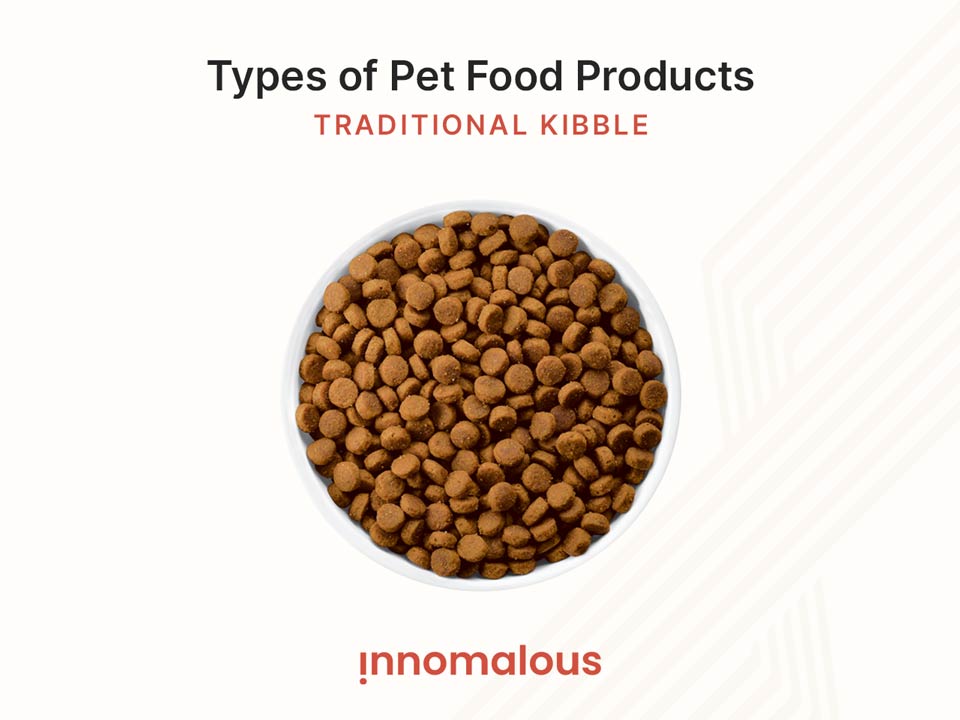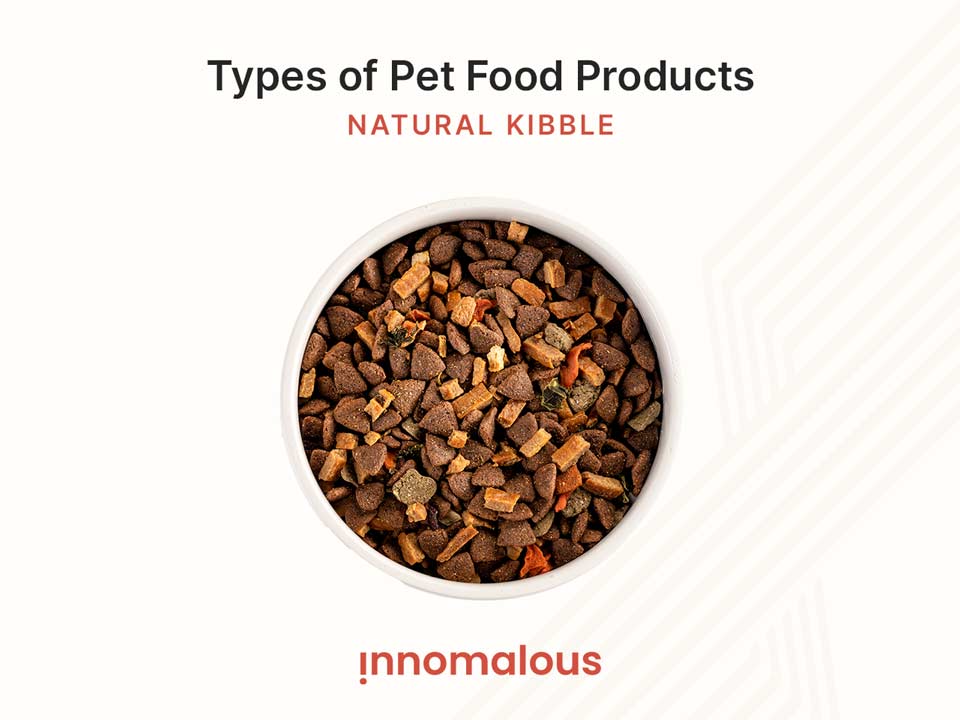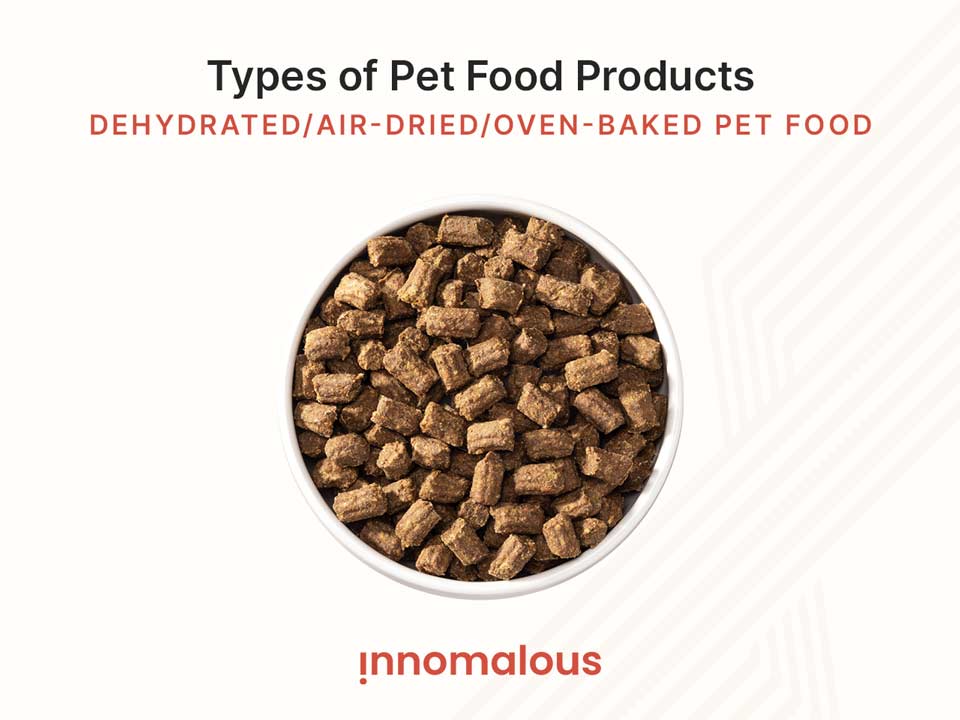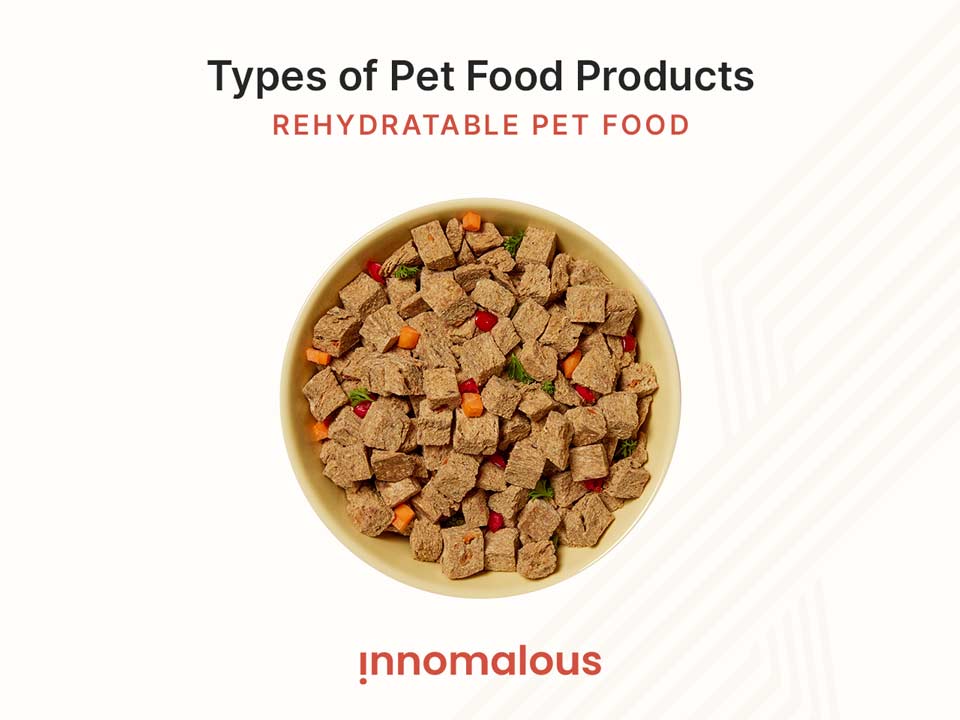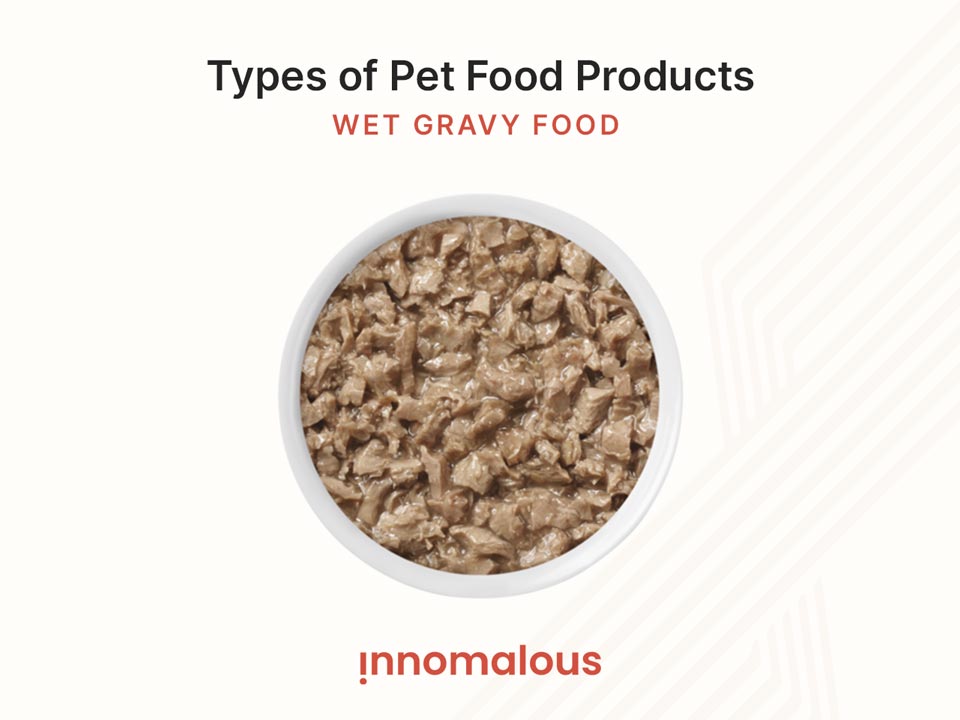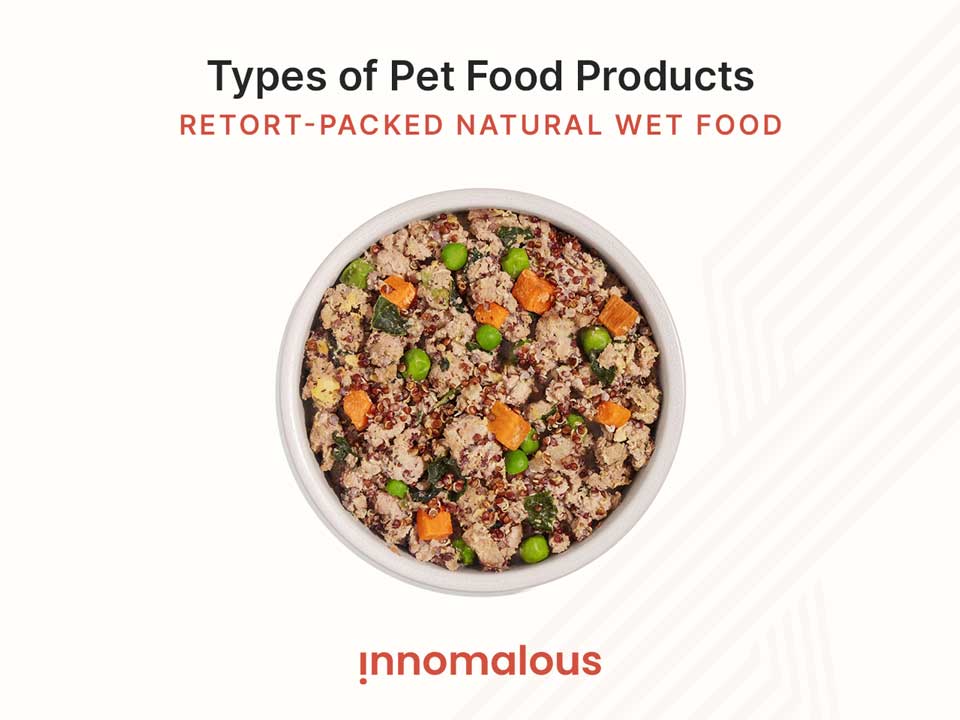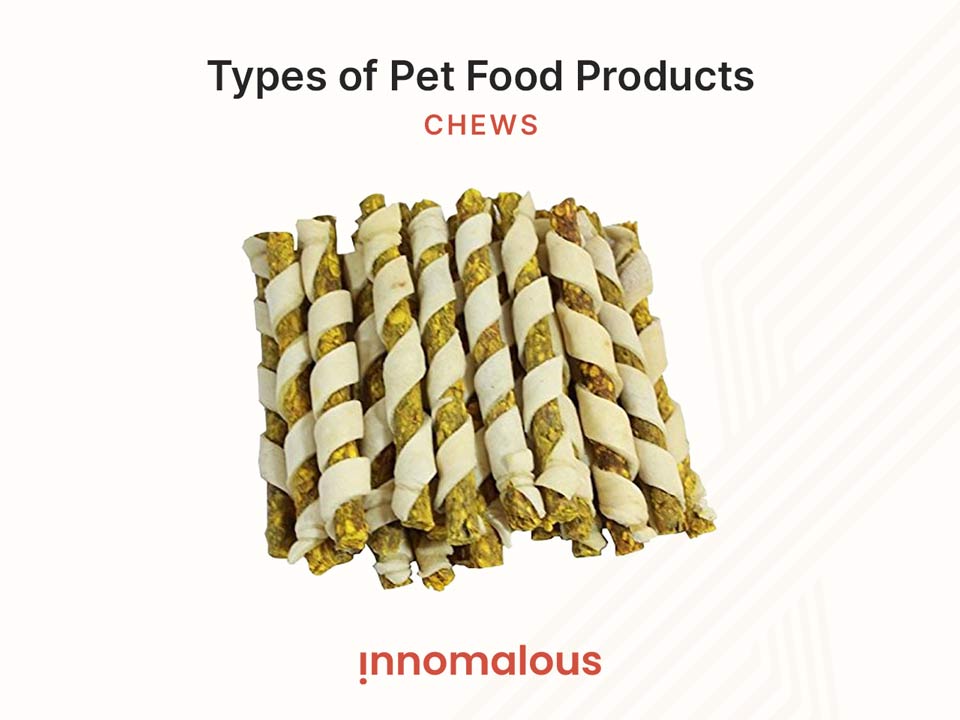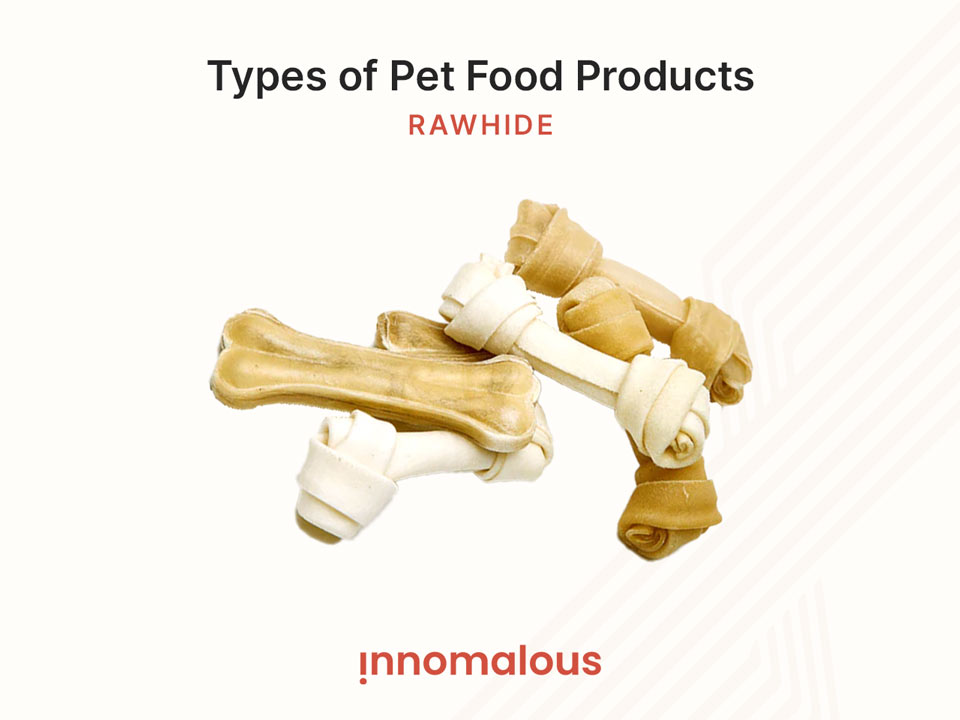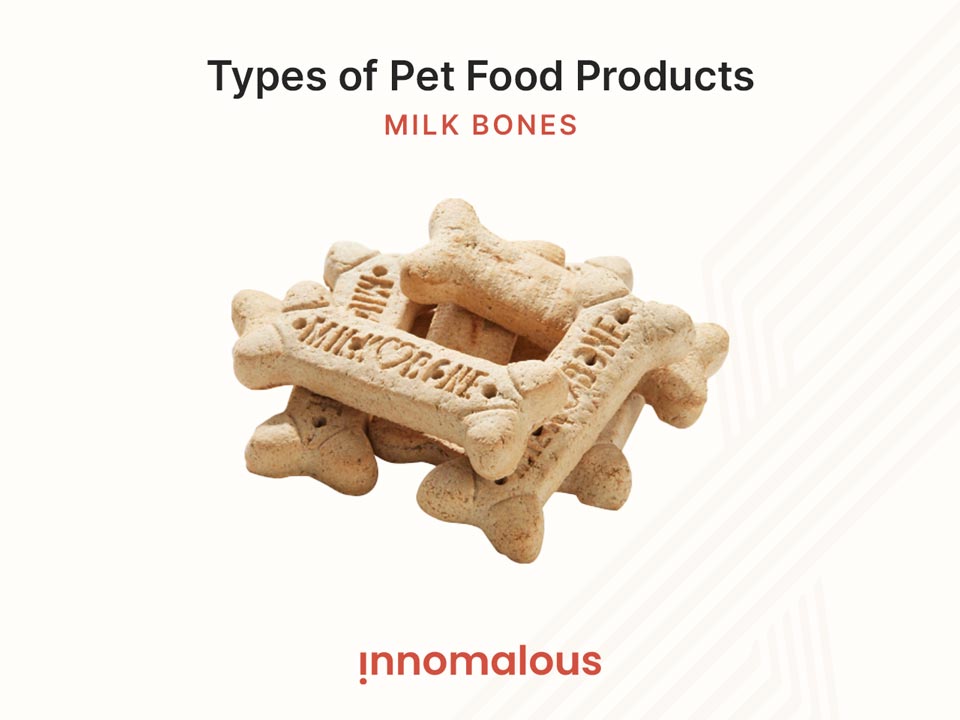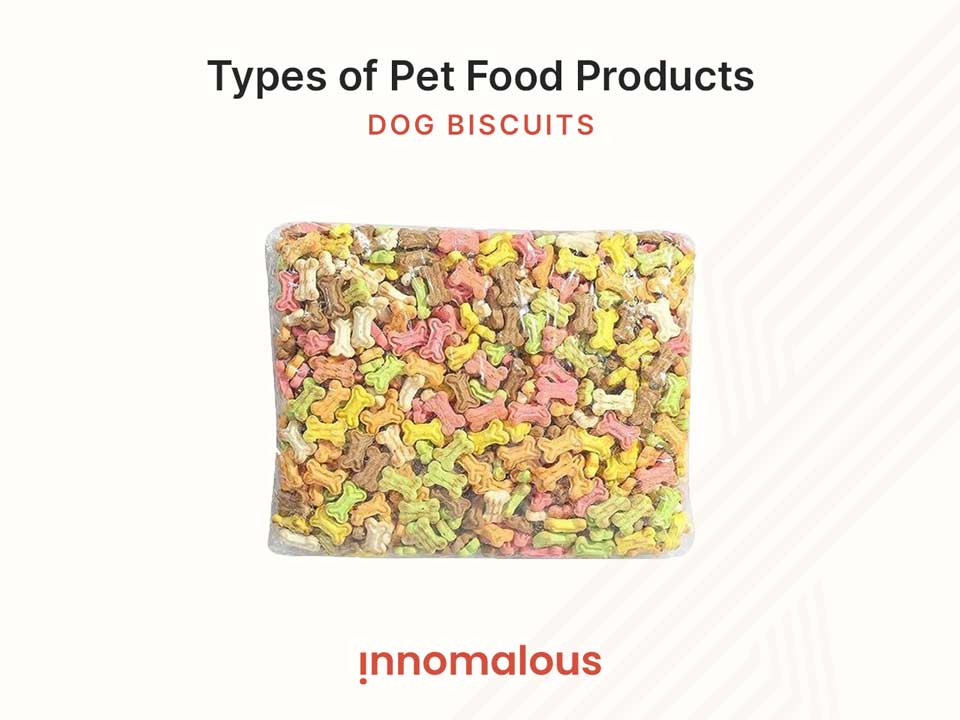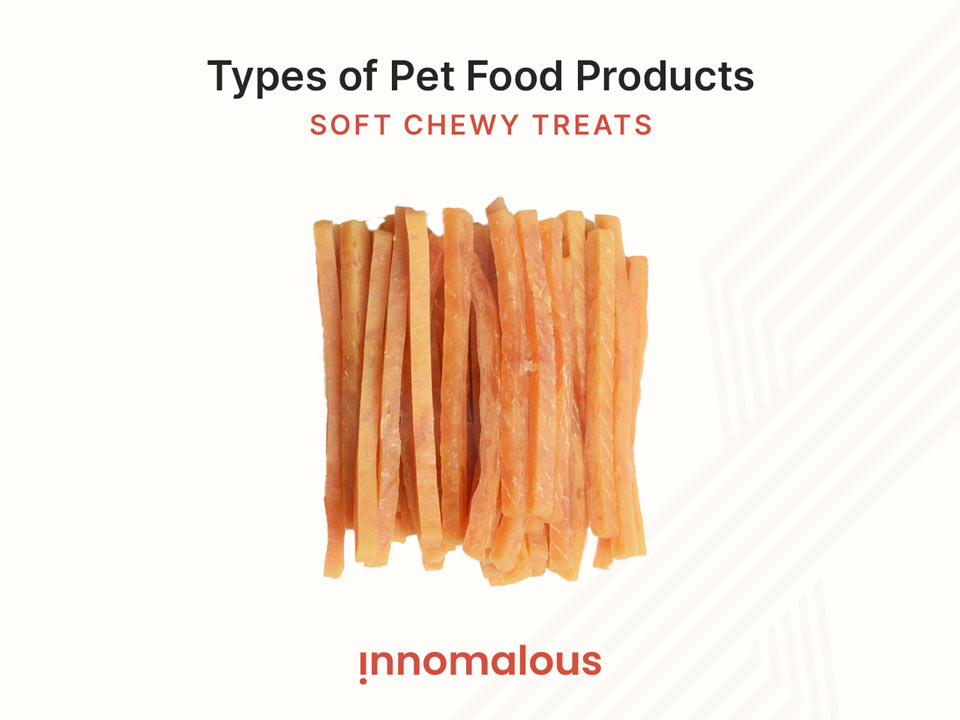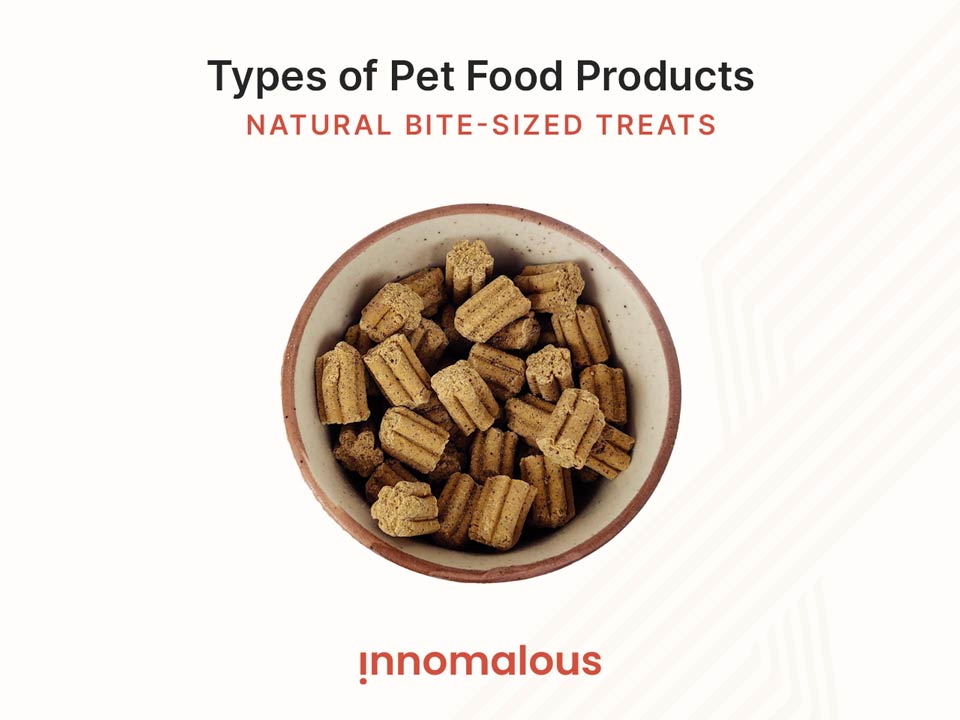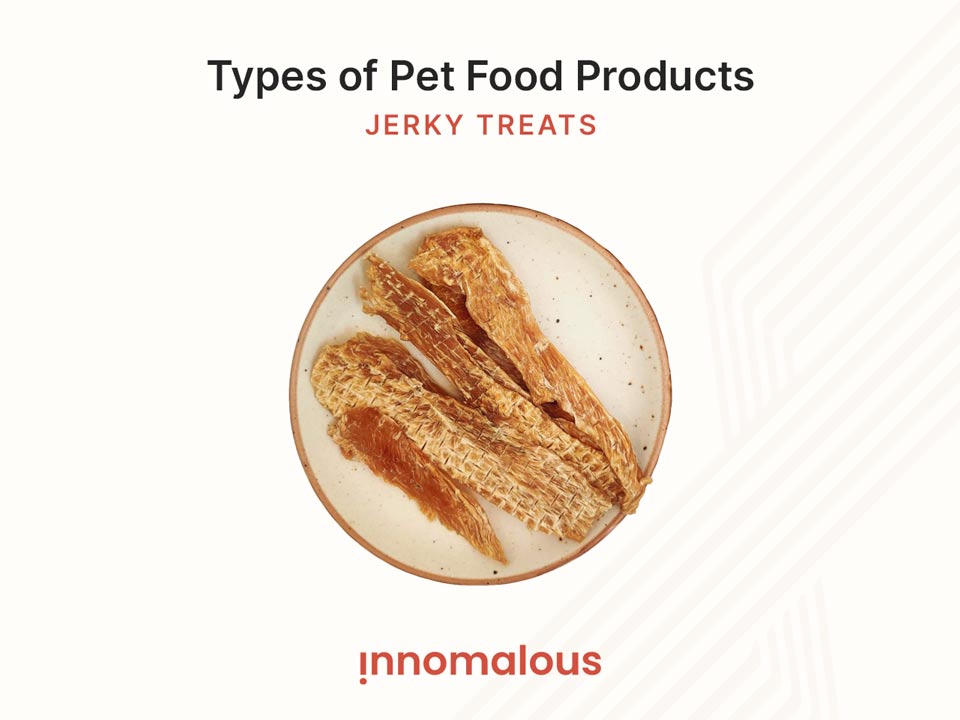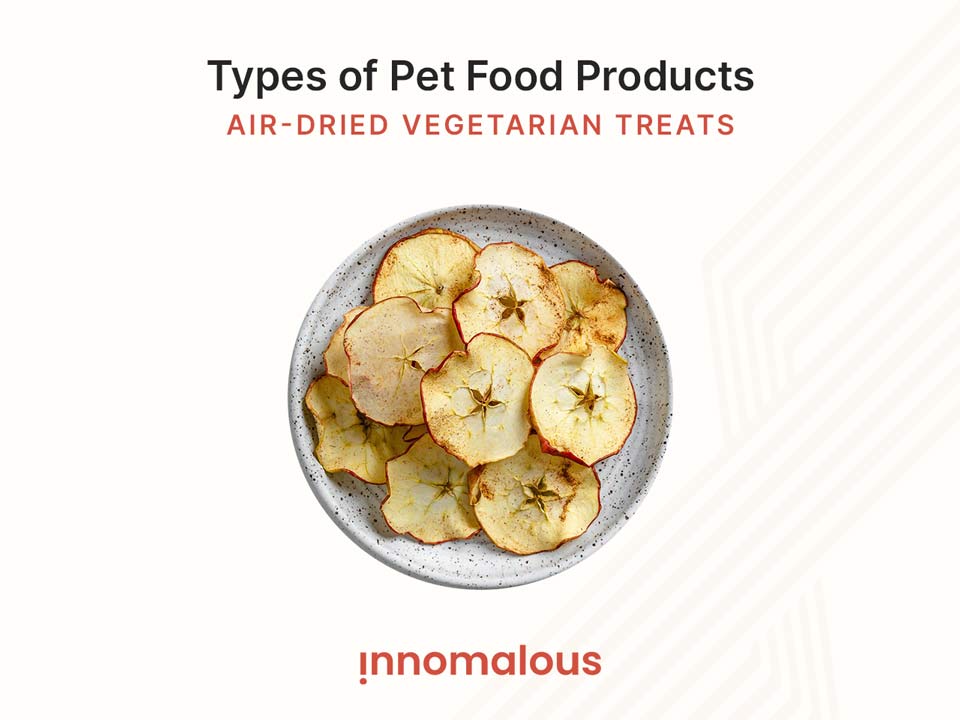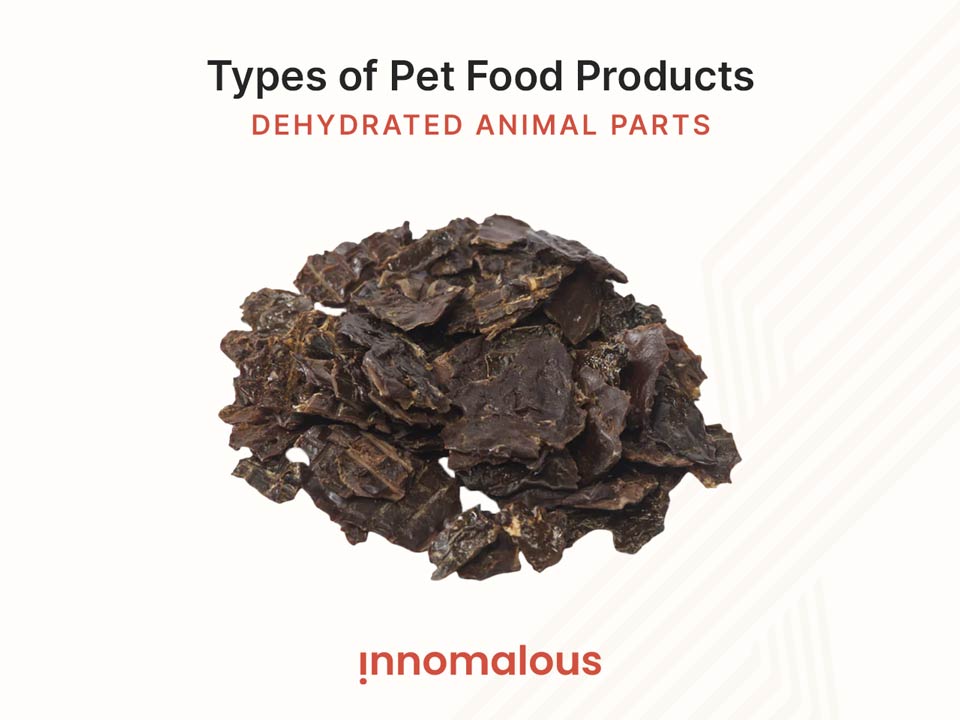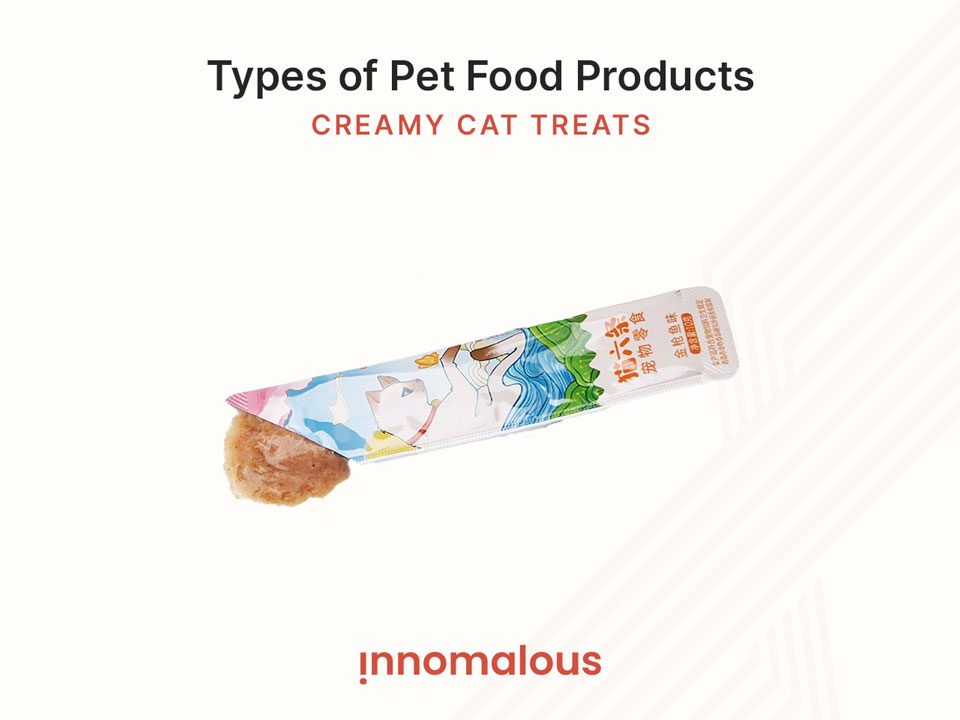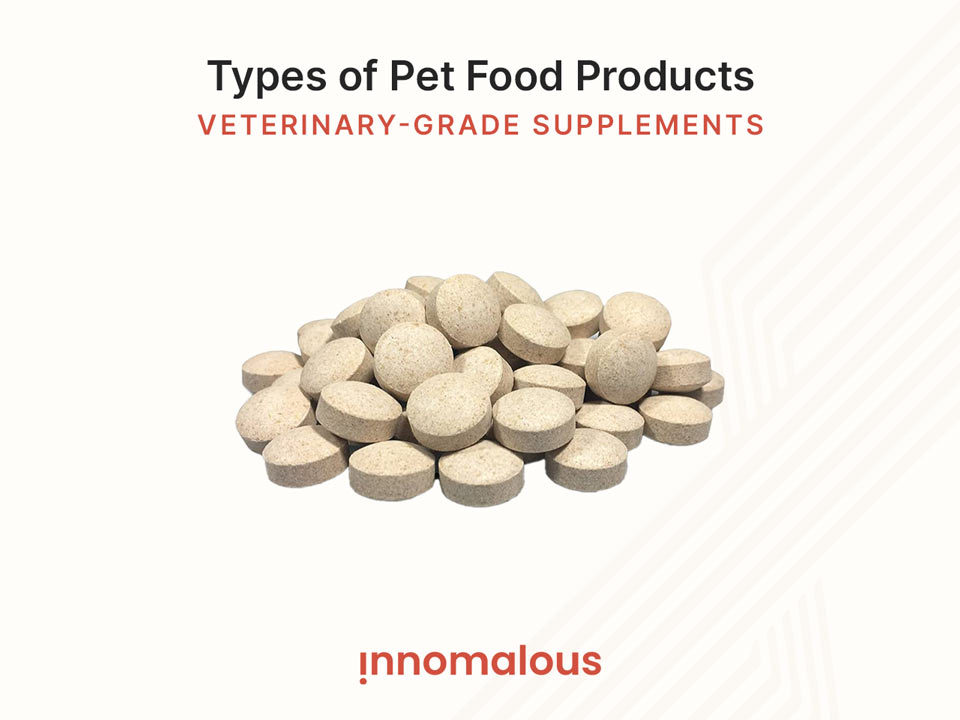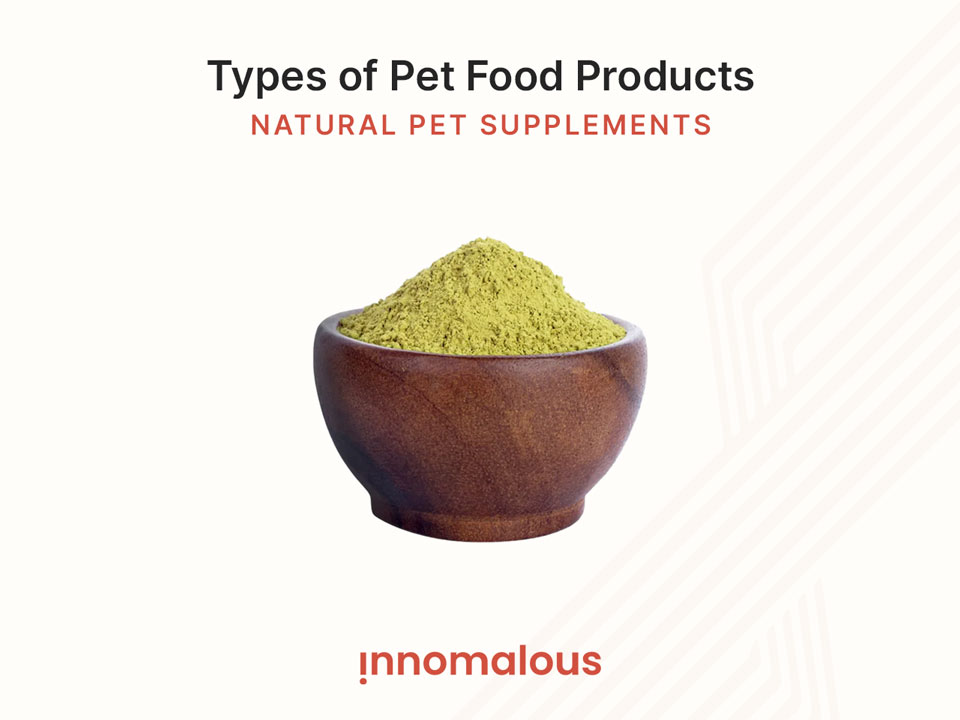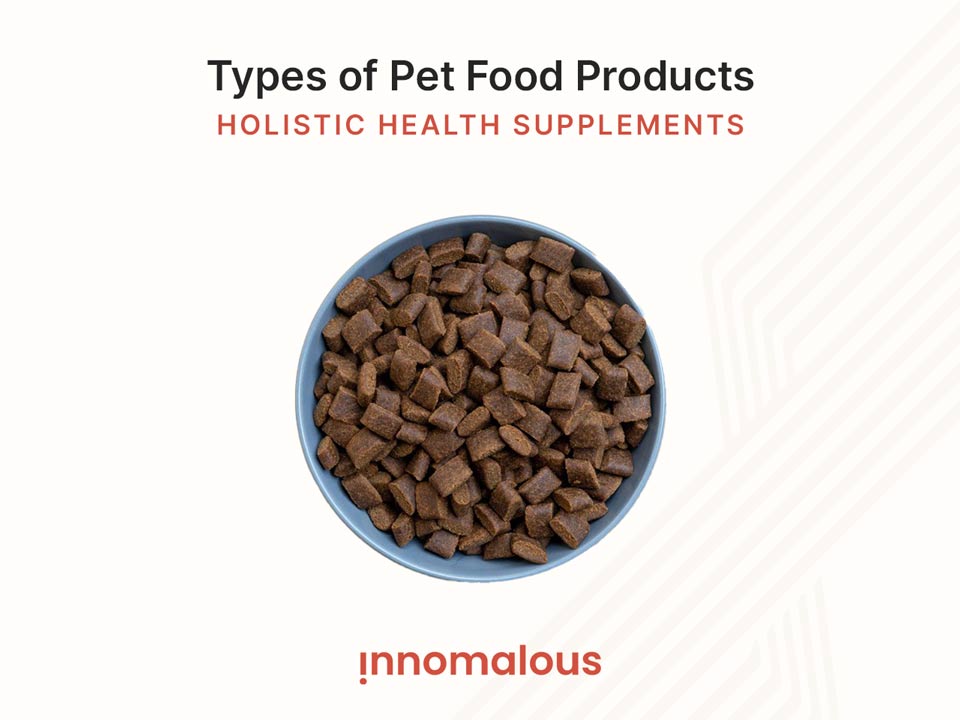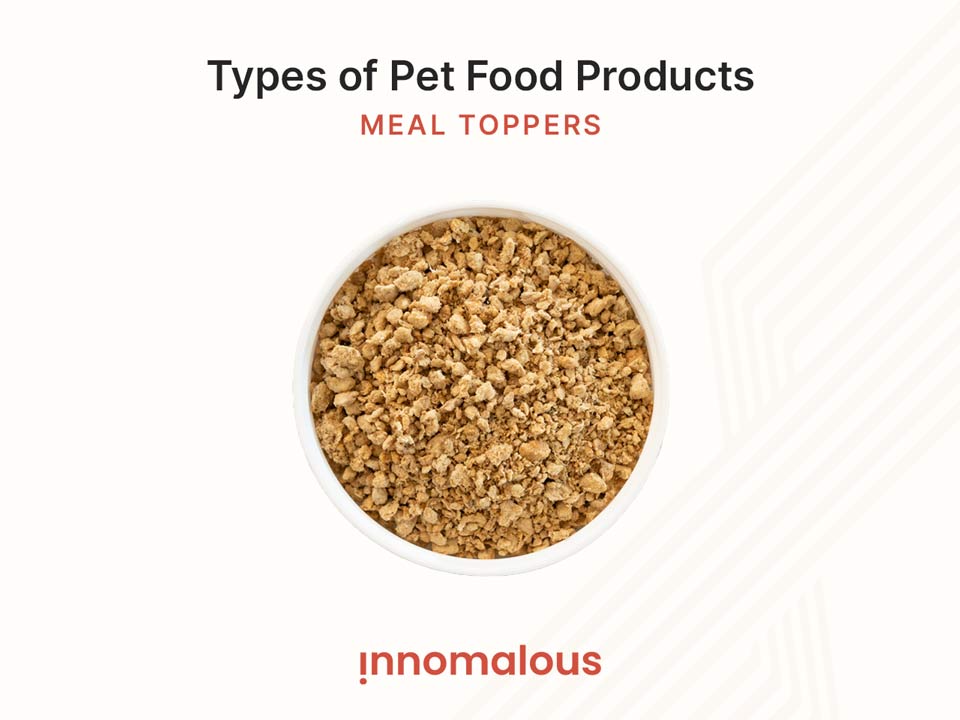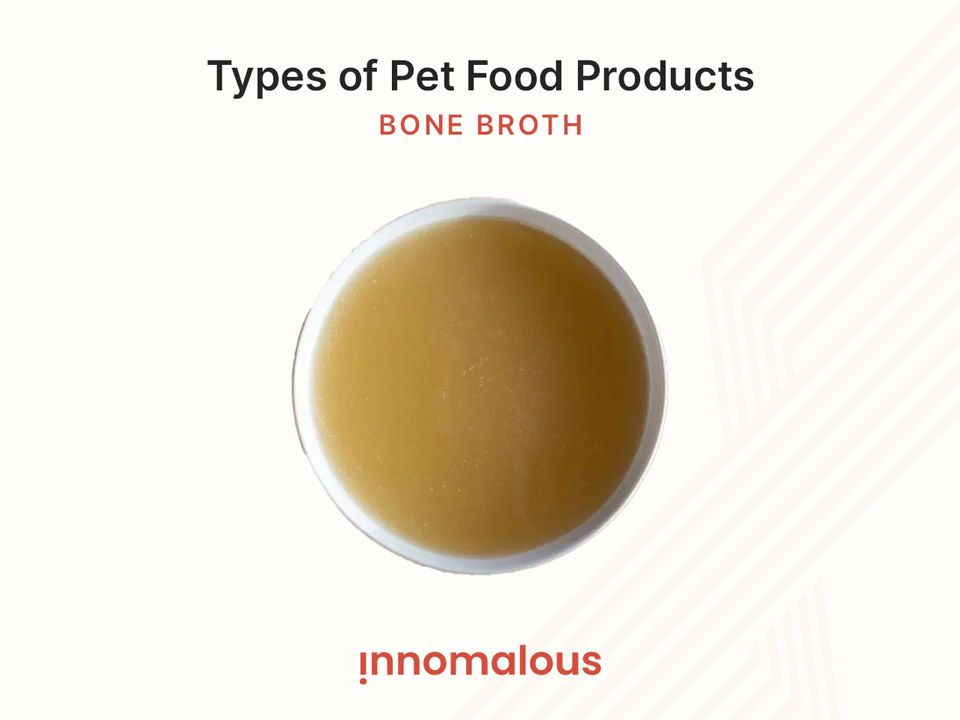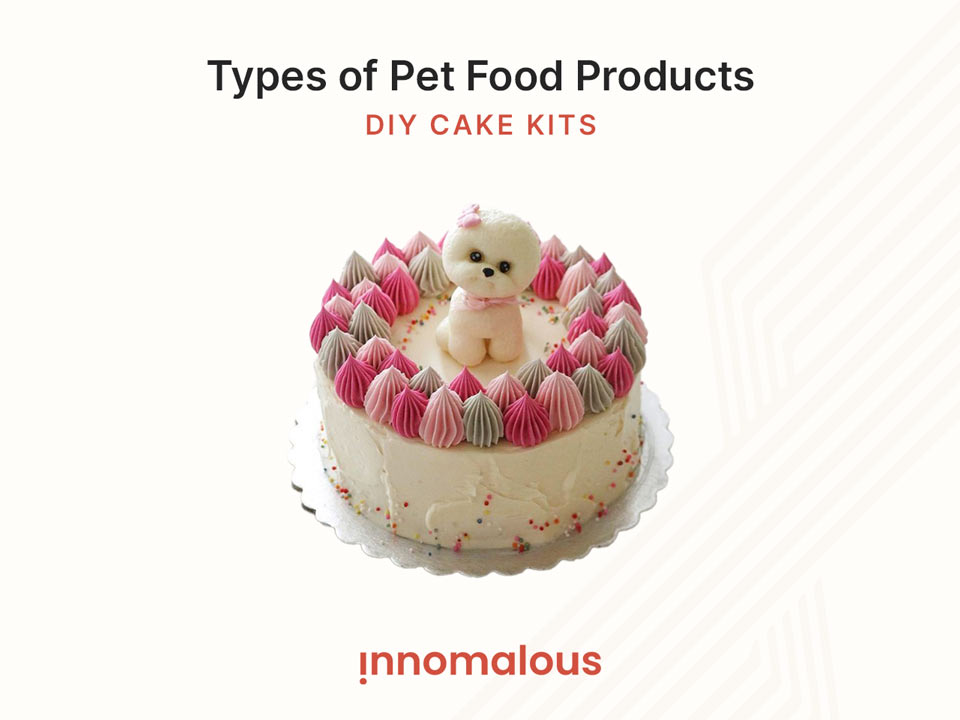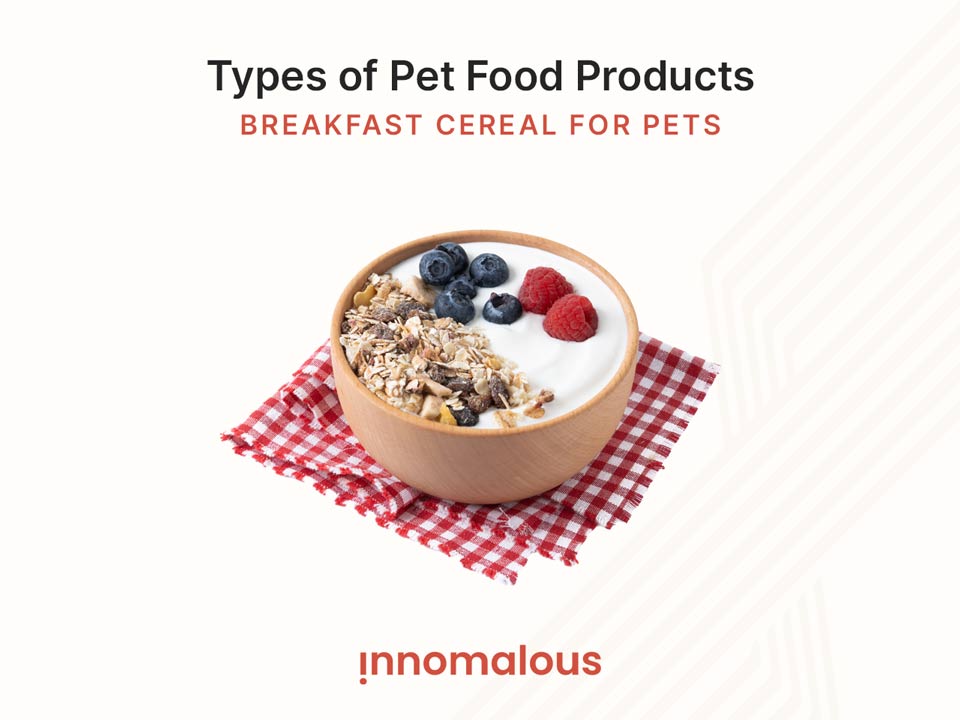Navigating the world of pet foods can get complicated, especially for beginners–there are a hundred different products and a thousand different marketing terms used to describe them.
If you have found yourself trying to understand pet food products, join us on our exploration, where we will dive into the essential aspects of pet nutrition, ingredient quality, demystifying pet food labels, the latest industry trends, and so much more. This journey will equip you with the information you need to create top-notch pet food products.
At Innomalous, our commitment to ‘Keeping Pets First’ drives us to empower pet industry entrepreneurs with knowledge that can transform the lives of pets and their families. We aim to highlight the importance of providing pets with high-quality, natural nutrition while fostering successful businesses.
Pet Food Industry Overview
Let us start by taking a step back and gaining a broader perspective on the pet food industry. The pet food sector is not just about feeding our furry friends; it’s a thriving and ever-evolving business landscape with significant opportunities, impressive growth, and its fair share of challenges.
The Growth Trajectory & Opportunities
Over the years, the pet food industry has witnessed remarkable expansion, with no signs of slowing down. As more people globally welcome pets home, the demand for high-quality pet food continues to soar. Pet food is one of the fastest-growing segments within the broader pet industry.
For aspiring pet industry entrepreneurs, this growth presents an enticing opportunity. The pet food market is not saturated, leaving room for innovation and unique, value-driven product creation.
Whether you are passionate about health-focused recipes, sustainable ingredients, or novel food concepts, there is ample space to carve out a niche and cater to the diverse needs of pet parents.
Not Without Controversies
However, it is not all smooth sailing. The industry has seen its share of scandals and controversies, which have raised questions about the quality and safety of pet food.
These incidents have underlined the importance of transparency, accountability, and a commitment to pet well-being. We will talk about them in more detail in the upcoming sections.
These challenges have made pet parents and entrepreneurs more discerning. They seek clear information about what goes into pet food, its nutritional value, and its impact on their pets’ health–as they should. This shift in consumer awareness has encouraged responsible brands to prioritize quality and transparency in their products.
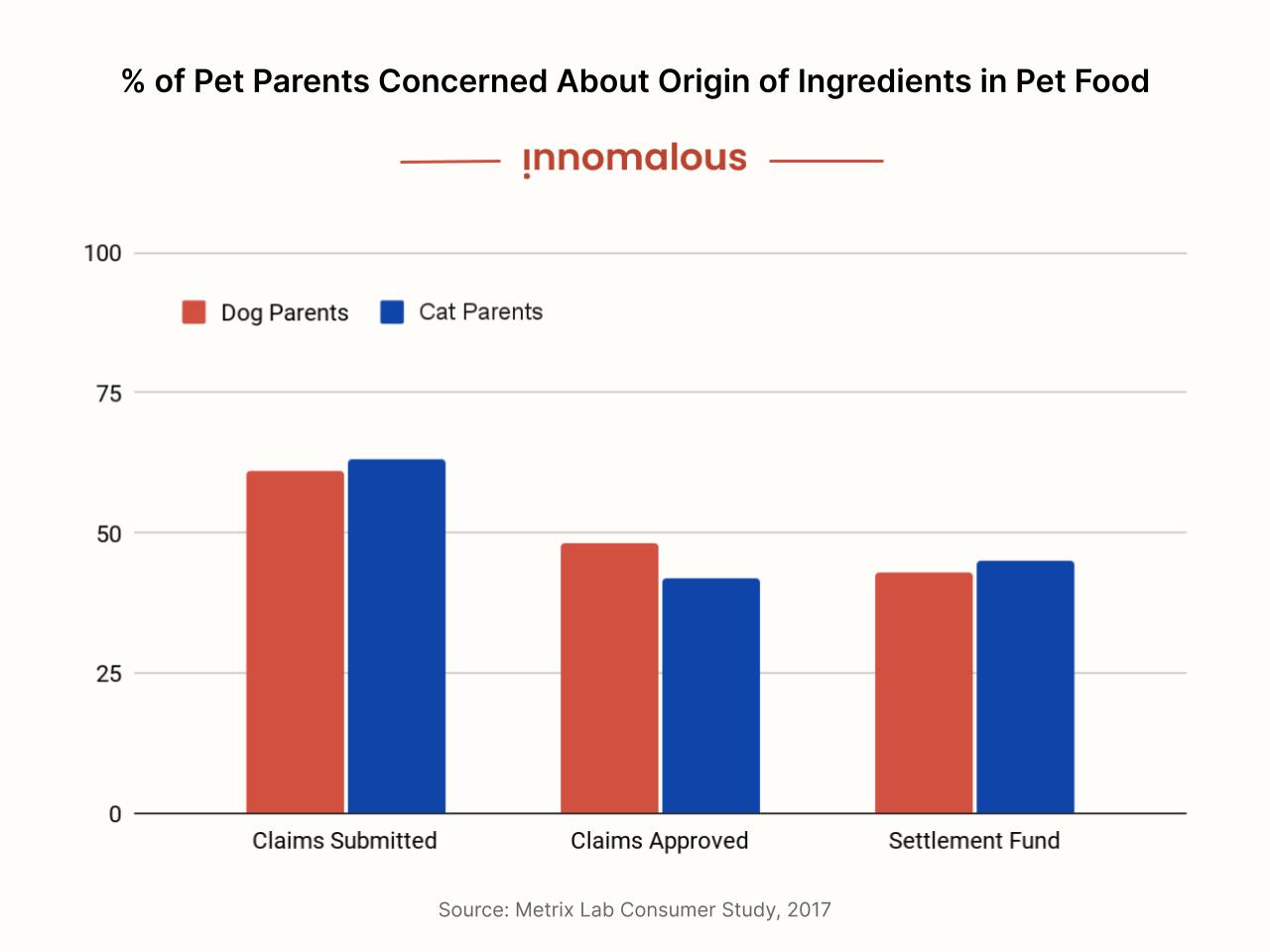
The 21st Century Pet Food Brand
Innovation, hence, plays a pivotal role in the industry’s growth. From exploring alternative protein sources to developing scalable natural solutions, pet food companies are continually pushing boundaries to meet the evolving demands of pet parents. This dynamic environment offers tremendous scope for those who dare to innovate.
As a business in the current day and age, there are no excuses for retailing low-quality, harmful, and even life-threatening products when better solutions and demand for them by pet parents exist.
The pet industry is a vibrant space for entrepreneurs dedicated to pet well-being and innovation. Like at Innomalous, we take pride in cultivating a community of successful new-age brands that elevate pets’ living standards globally.
But this hasn’t always been the case in the pet food world. Turning the pages of history shows where the industry started and how far it has come. Take a peek!
Tracing the History of Pet Food: From Humble Beginnings to Modern Marvels
Our exploration of pet food would not be complete without delving into its intriguing history. The tale of pet nutrition unfolds through the ages, from the humble origins of sharing table scraps with our animal companions to the sophisticated, specialized diets available today.
In this section, we embark on a historical journey, uncovering the milestones and transformations that have shaped the pet food industry into what it is.
Inception and Early Days
We can trace the origins of commercial pet food back to an era when the primary diet of pets was leftovers of their human companions. This practice prevailed for centuries, reflecting that pets, back then, were working animals rather than family members. The concept of dedicated pet food was a nascent idea, waiting for its moment in the sun.
James Spratt and the Birth of the Dog Biscuit
The turning point in the history of pet food arrived in 1860 when James Spratt, an American electrician, set sail for England. He observed people feeding dogs leftover ship biscuits on his journey. Inspired by this observation, Spratt created the first commercially prepared dog biscuit, "Spratt’s Patent Meat Fibrine Dog Cakes."
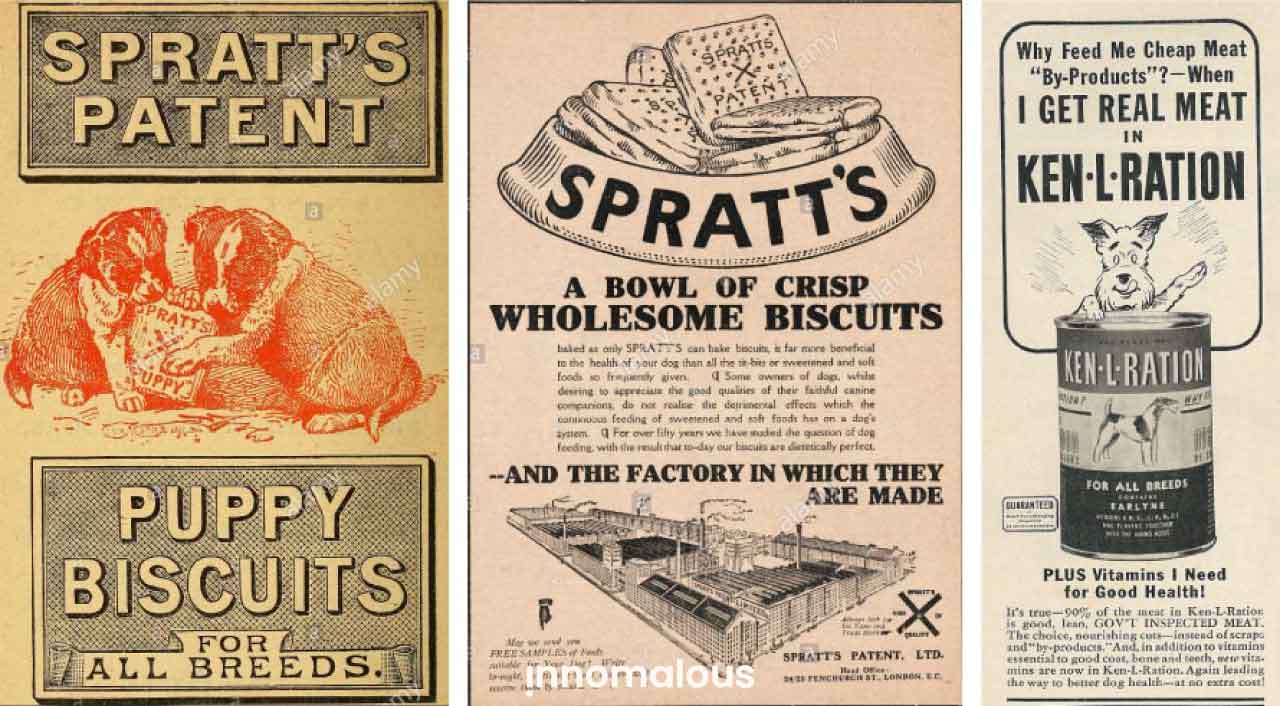
These early dog biscuits were a breakthrough, designed to be convenient and nutritious. They gained popularity among pet parents and working dogs, such as those on ships and farms. Spratt’s invention marked the inception of the pet food industry.
Transition from Homemade to Processed Food
As the 20th century dawned, the pet food industry began to take root. Companies saw an opportunity to provide pet parents with convenient and reliable pet food options. The shift from homemade meals to processed pet food represented a significant evolution.
Early pet foods included kibble and canned options, which offered convenience and a longer shelf life than homemade meals. These products became increasingly popular, reflecting changing lifestyles and the desire for more practical pet-feeding solutions.
Formation of an Industry: The Birth of Commercial Pet Food
A pivotal shift took place in the pet nutrition landscape in the early 20th century as the concept of commercial pet food took root and began to flourish. This transformation marked the formalization and expansion of a multi-billion-dollar industry.
Emergence of Commercial Pet Food
With industrialization gaining momentum, people’s lifestyles changed. This change led to an increased need for convenient and reliable pet-feeding solutions.
Enterprising individuals recognized this emerging demand and seized the opportunity to create dedicated pet food products. Companies like Spratt’s, F.H. Bennett Biscuit Company, and Ken-L Ration emerged as pioneers in this budding industry.
They introduced a range of commercial pet foods, including kibble and canned options, which revolutionized pet food.
These early pet foods gained traction among pet parents, who appreciated the convenience of pre-packaged meals. Marketing efforts highlighting the benefits of commercial pet foods propelled its acceptance further.
Pet owners no longer relied solely on homemade meals but embraced the newfound ease of feeding their pets.
Basic Processes and Ingredients
During this period, the processes and ingredients used in pet food manufacturing were relatively rudimentary compared to modern standards. Meat byproducts, grains, and fillers were common components of early pet foods.
While these ingredients provided baseline nutrition, quality control and ingredient sourcing were less stringent, leading to variability in product quality.
As the industry matured, it began to diversify. Pet food companies started offering an extensive product range tailored to different needs and preferences. Specialized diets for puppies, senior dogs, and specific breeds emerged, reflecting a growing understanding of the unique nutritional requirements of pets.
The formation of the pet food industry was a watershed moment, transforming pet nutrition from a simple act of sharing leftovers into a structured and evolving field.
Challenges and Scandals in the Pet Food Industry
The pet food industry faced its share of challenges and scandals while growing. Contaminations, mislabeling, and recalls prompted scrutiny and raised questions about the safety and transparency of pet food production.
The Melamine Contamination Scandal (2007)
One of the most infamous incidents in pet food history, this scandal involved widespread contamination of pet food with melamine, a toxic chemical. It led to the illness and death of numerous pets across the United States.
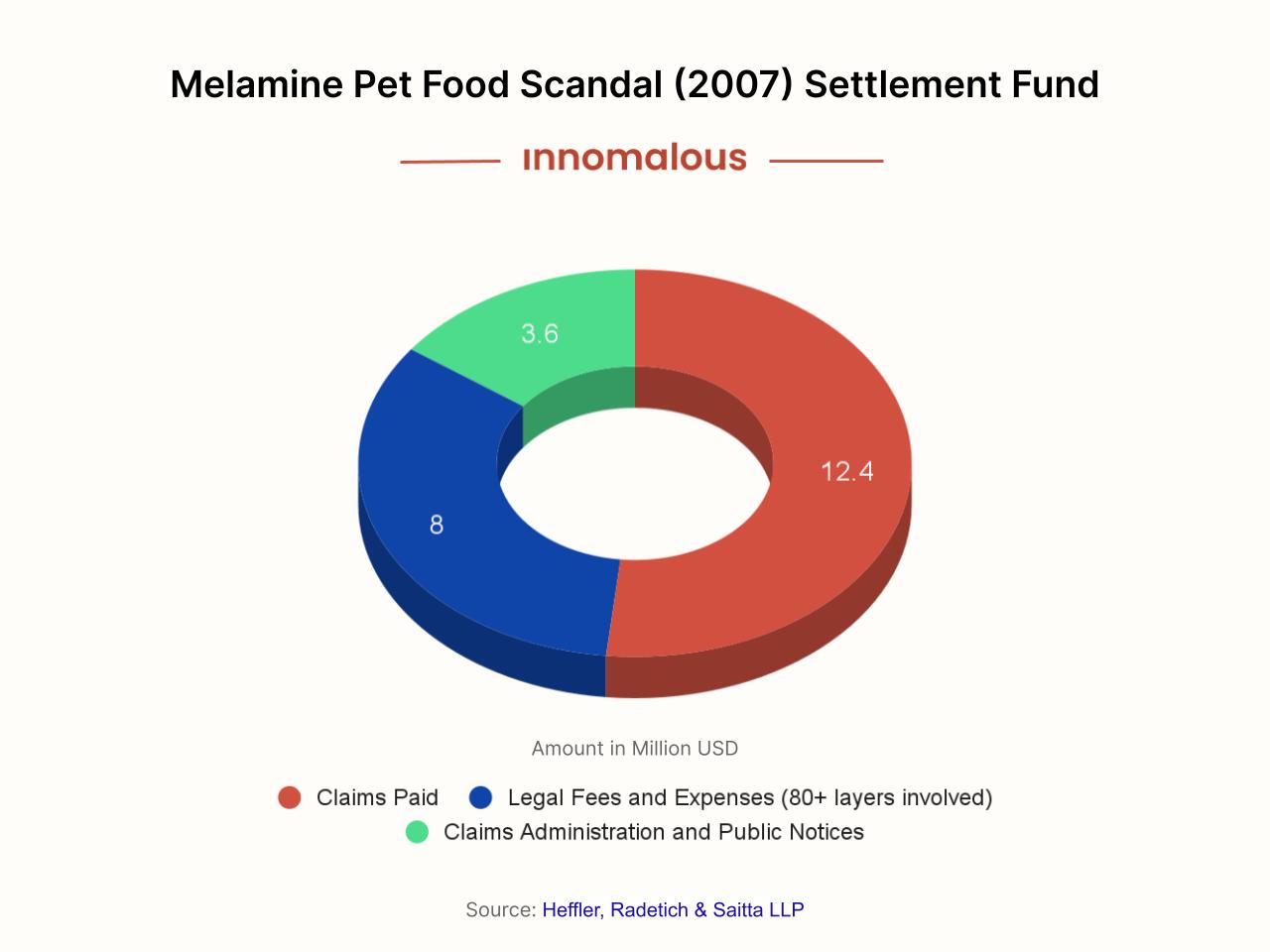
This tragedy underscored the critical need for rigorous quality control and ingredient sourcing in pet food production.
Misleading Labeling and Ingredients
Pet food brands have consistently faced criticism for misleading labeling practices. This inaccuracy includes claims of using premium ingredients when using lower-quality substitutes in reality.
Such incidents have eroded consumer trust and highlighted the importance of transparent labeling and accurate ingredient representation.
Lack of Nutritional Clarity
The pet food market can confuse consumers due to varying nutritional standards and guidelines. Some pet parents have been left uncertain about the nutritional adequacy of certain products.
This distrust has created an opportunity and demand for brands that prioritize clear nutritional information and scientifically backed formulations.
Recalls and Safety Concerns
Recalls of pet food products due to contamination or safety issues have been a recurring challenge. These recalls, often associated with bacterial contamination or other safety concerns, can lead to pet illnesses and legal repercussions.
They emphasize the importance of stringent quality assurance measures.
Sustainability and Ethical Concerns
The scrutiny and growing focus on sustainability and ethical sourcing in the food industry has fallen on pet foods too. Concerns about the environmental impact of certain pet food ingredients and animal welfare concerns in sourcing practices have prompted consumers to seek more responsible brands.
In navigating these challenges and learning from past scandals, responsible pet food manufacturers like Innomalous have adopted stricter quality control measures, transparent ingredient sourcing, and a commitment to ethical and sustainable practices. These efforts are vital for pet safety and resonate with conscientious pet parents who prioritize the health and well-being of their beloved companions.
The Natural Revolution
The challenges and scandals in the pet food industry catalyzed change. Pet owners, becoming more discerning and concerned about pet well-being, started seeking healthier, more natural alternatives. This shift in consumer demand spurred the Natural revolution in pet food.
Today, pet food companies are redefining the industry by emphasizing high-quality, natural ingredients. Premium pet food manufacturers like Innomalous prioritize transparency, responsible sourcing, and nutritional excellence.
The natural revolution in pet food reflects the growth and transformation of the industry and showcases a commitment to the well-being of our beloved pets. It is a testament to the ever-evolving landscape of pet nutrition, where innovation and consumer awareness drive positive change.
The Science of Pet Nutrition: Nourishing Our Companions
As pet parents first, our commitment to our furry friends extends beyond love and companionship–it encompasses their health and well-being. Central to this commitment is understanding the intricate world of pet nutrition.
This section will delve into the science behind pet nutrition and understand the essential components that constitute species-appropriate, high-quality pet food products.
Macronutrients and Micronutrients
Two primary categories of nutrients play a pivotal role in sustaining pet health, growth, and vitality: macronutrients and micronutrients. Let us learn what makes these nutrients indispensable for pets.

Macronutrients: The Building Blocks of Nutrition
Macronutrients are the fundamental components of pet food, providing essential energy and structure for their bodies. They include,
Proteins
Often called the "building blocks of life," proteins are critical for growth, muscle maintenance, and overall body structure. They also play a principal role in enzyme and hormone production.
Fats
Dietary fats are a concentrated energy source, essential for the functioning of cells, absorption of fat-soluble vitamins, and maintaining healthy skin and coat.
Carbohydrates
While pets don’t require as many carbohydrates as humans, they still serve as a source of energy and fiber, aiding digestion and promoting bowel regularity.
These building blocks serve many functions in pet survival and well-being, the most important ones being,
Growth
Adequate protein intake is crucial during growth stages, ensuring the development of healthy muscles and tissues.
Energy
Fats and carbohydrates are primary energy sources, keeping pets active and playful.
Skin & Coat Health
Fats, especially Omega-3 and Omega-6 fatty acids, contribute to lustrous coats and healthy skin.
Digestive Health
Carbohydrates provide dietary fiber, aiding in proper digestion and preventing constipation.
Micronutrients: The Tiny Titans
Micronutrients are the unsung heroes of pet nutrition, required in smaller quantities but with equally profound impacts. They encompass,
Vitamins
Essential for various bodily functions, vitamins include A, B complex, C, D, E, and K, each serving specific roles, from immune support to bone health.
Minerals
Critical minerals like calcium, phosphorus, and magnesium contribute to strong bones, proper nerve function, and fluid balance.
An adequate supply of these micronutrients can improve pet health in many ways. The most evident ways are,
Bone Health
Minerals, particularly calcium and phosphorus, are essential for strong bones and teeth.
Immune Support
Vitamins like C and E act as antioxidants, bolstering the immune system and protecting against oxidative stress.
Nervous System Function
Minerals like magnesium play a role in nerve signal transmission.
In sum, macronutrients and micronutrients are the cornerstones of pet nutrition, serving as the fuel and catalysts for life-sustaining processes. As responsible pet business owners, understanding and ensuring a balanced intake of these nutrients in pets’ diets promotes their health and growth.
Changing Needs at Different Lifestages
As consumer demands vary throughout a pet’s life, so must our approach to crafting pet food products. Understanding the distinct nutritional requirements of pets at different life stages is vital for pet food business owners aiming to develop products that cater to these specific needs.
Let us explore the essential nutritional considerations for each life stage and how we can craft pet food formulations thoughtfully to meet these demands.
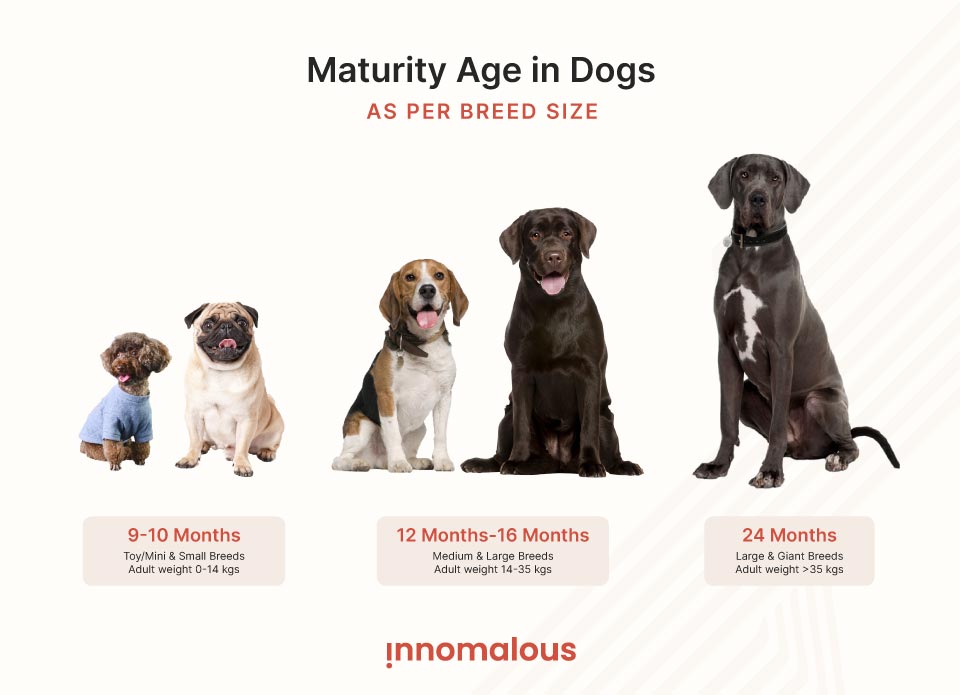
Puppies and Kittens: The Foundation of Growth
Protein (Approximately 28-32%)
Pet food for puppies and kittens should contain higher protein levels to support their rapid growth. High-quality protein sources like chicken, fish, or lamb are crucial for muscle and tissue development.
Caloric Density (10-20% higher than adult formulas)
Young pets have elevated energy requirements due to their active nature. Developing formulas with increased caloric density provides the necessary fuel for their boundless energy.
Calcium (Around 1.1-1.5%)
Ensuring correct calcium levels is essential for strong bone and teeth development.
DHA (Docosahexaenoic acid)
Incorporating DHA, typically at around 0.1%, supports cognitive development, a critical selling point for puppy and kitten formulas.
Multiple Feeding Times
Due to their smaller stomach capacity, young pets benefit from multiple, smaller meals throughout the day, a valuable consideration for product design.
Adult Pets: Maintaining Health and Vitality
Balanced Nutrition
Formulations for adult pets, with approximately 18-25% protein, 10-15% fats, and carbohydrates, should provide balanced nutrition to sustain their overall health.
Weight Management
Products tailored for adult pets should consider calorie levels that help maintain an ideal body condition as many pets suffer from obesity in adulthood due to poor diets.
Joint Health
Consider adding supplements like glucosamine and chondroitin to support joint health, particularly in larger dog breeds.
Seniors: Nurturing Well-Being in Golden Years
Reduced Calories (Around 10-20% lower than adult formulas)
Senior pet products typically need lower calories to cater to their decreased energy requirements.
Joint and Muscle Support
Including ingredients like Omega-3 fatty acids (usually around 0.3-0.5%) and antioxidants appeals to the senior pet market, addressing joint and cognitive health concerns.
Digestive Health
Senior-specific formulas may contain added fiber (approximately 4-6%) to promote digestive health, a compelling feature for products in this category.
Protein Quality
Highlight the quality of proteins used in senior pet products to support muscle maintenance.
Hydration
Consider developing wet food or rehydratable options, which provide added moisture and address hydration concerns in senior pets.
By recognizing and addressing the changing nutritional needs of pets at different life stages, pet food business owners can develop products that resonate with both pet parents and the pets themselves. Crafting formulas that cater to these evolving requirements ensures that pets receive the necessary nutrients at the right time, supporting their health and well-being lifelong.
High-Quality Protein Sources: The Backbone of Pet Nutrition
As pet food business owners, you understand that the cornerstone of a successful pet food product lies in the quality of its ingredients. Among these, protein plays a pivotal role in the nutrition and well-being of our four-legged companions.
In this section, we will learn why high-quality protein sources are the bedrock of pet nutrition and how they contribute to muscle development, immune support, and overall vitality in pets.
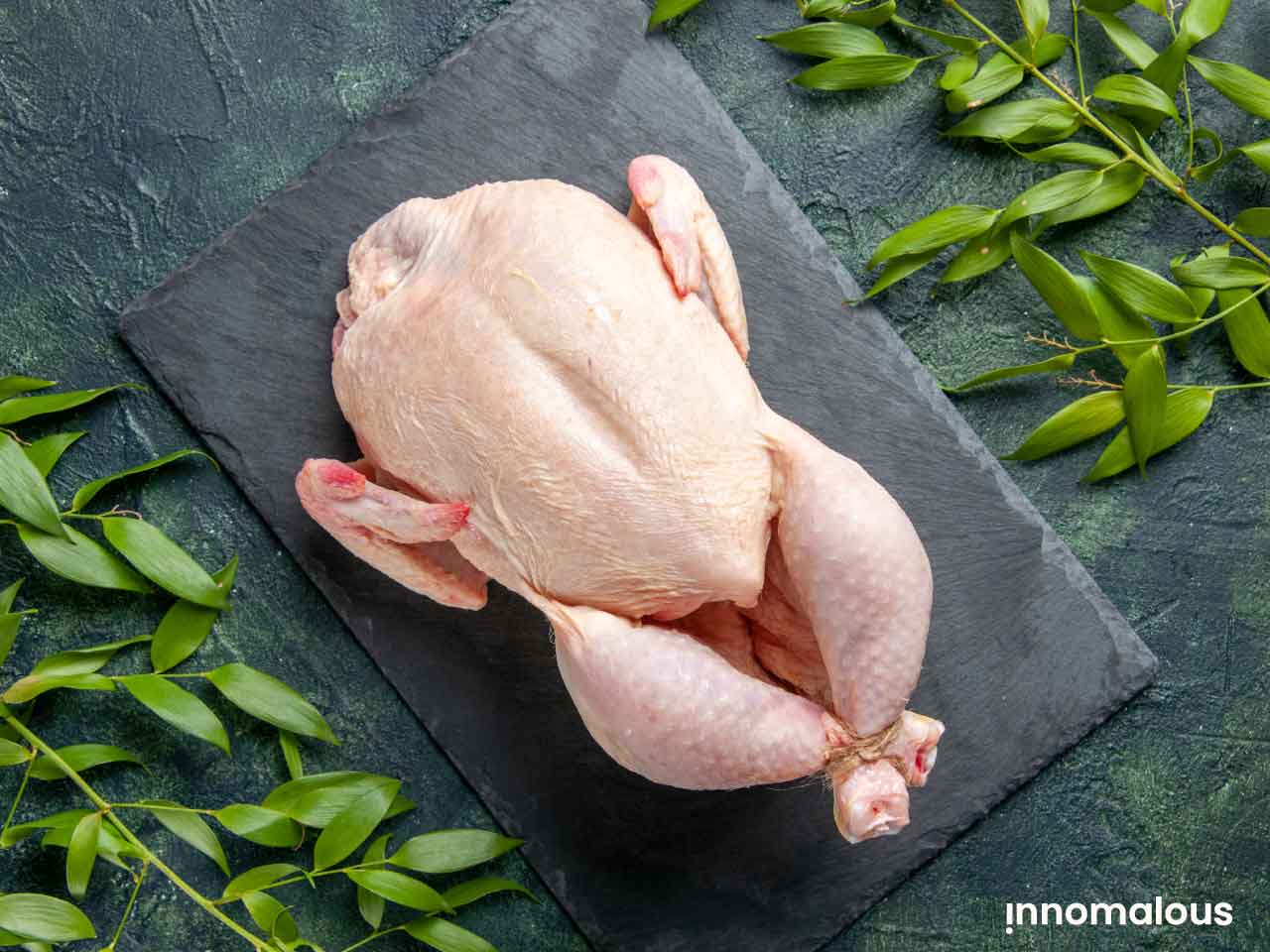
Understanding Amino Acids
Amino acids are the basic structural units of proteins. There are two categories of amino acids: essential and non-essential.
Essential Amino Acids are amino acids that pets must obtain through their diet because their bodies cannot synthesize them independently. Dogs need ten essential amino acids arginine, histidine, isoleucine, leucine, lysine, methionine, phenylalanine, threonine, tryptophan, and valine for dogs. Cats need all of these and taurine.
If the pet’s body synthesizes a type of Amino Acid, it is considered Non-essential. Hence, you may not have to supply non-essential amino acids through pet food.
Quantity vs. Quality of Protein In Pet Foods
Meeting the protein requirements for pets is just as much about quality as it is about quantity. High-quality protein sources provide the complete package of essential amino acids, enabling pets to thrive at their best.
High-quality protein sources, such as lean meats, fish, and eggs, are abundant in essential amino acids. They provide a well-rounded and balanced amino acid profile that meets the unique nutritional requirements of pets.
Premium protein sources ensure that pets receive a full spectrum of amino acids, supporting muscle development, immune function, and overall vitality. When pet food formulations incorporate high-quality protein sources, they inherently supply the essential amino acids pets require for a thriving life.
High-quality proteins are easily digestible and bioavailable, ensuring that pets can efficiently absorb and utilize these critical nutrients.
The Shortcomings of Low-Quality Protein in Pet Food
Low-quality protein sources are less expensive, making them appealing from a cost perspective for some pet food manufacturers. In some cases, these proteins are used as fillers to increase the protein content on the label without considering their nutritional value.
Some popularly used low-quality protein sources are,
Chicken Meal
While chicken meal is a common ingredient in pet foods, the quality can vary drastically. High-quality chicken meal is a concentrated source of protein, while lower-quality versions contain byproducts and excessive ash content, reducing its nutritional value.
Meat Byproducts
Meat byproducts are another low-quality protein source. They may include less desirable parts of animals–bones, nails, and hide from untraceable animal sources. These byproducts also offer far less nutritional value compared to real muscle meat.
Soy
Soy protein is frequently a filler in pet food products due to its lower cost. However, it lacks certain essential amino acids, making it an incomplete protein source.
Corn
Corn gluten meal is another low-cost protein source used in pet foods. It’s not as easily digestible as animal-based proteins and may lead to digestive issues in pets.
Wheat
Wheat is a less desirable protein source due to its lower amino acid profile. It can also trigger allergies or sensitivities in some pets.
Plant-Based Fillers
Inexpensive plant-based protein fillers like pea and rice protein may not provide the complete amino acid profile pets need for optimal health and may have low absorption.
However, they boost the protein number on pet food labels. This property makes them a lucrative option for pet food brands at the cost of pet health.
While there are many reasons to avoid using these ingredients in your pet food product, the most compelling reason is their adverse impact on pet health. Traditional pet foods using these ingredients commonly face recalls and complaints. As a modern pet food brand, such feedback can ruin your reputation among pet parents irreparably.
These are some common health issues caused by low-quality protein in pet foods.
Low-quality protein sources often lack the essential amino acids required for pet health. This insufficiency can lead to nutritional deficiencies and impact muscle development, immunity, and cognitive function.
Pet foods containing low-quality proteins are also strenuous for pets to digest, potentially resulting in gastrointestinal discomfort such as gas, diarrhea, or constipation.
Low-quality proteins are more likely to trigger allergies or sensitivities in pets, leading to adverse reactions and discomfort.
The drawbacks and risks associated with using low-quality protein sources in your pet food far outweigh any cost benefits they may bring. These ingredients on your pet food label immediately relegate your product to a low-quality offering and may turn away customers looking for quality options.
Fats and Fatty Acids: Nurturing Skin, Coat, and Cognitive Health in Pets
Often overlooked, fats are equally crucial as proteins in pet food. As pet food business owners, understanding the significance of fats, including essential fatty acids like Omega-3 and Omega-6, is paramount.
Let us explore how fats contribute to maintaining healthy skin, a lustrous coat, and cognitive function in our beloved pets.

Fats: The Unsung Heroes
Fats supply concentrated energy and enable vital bodily functions in pets. They also aid the absorption of fat-soluble vitamins (A, D, E, and K) and contribute to overall well-being.
High-quality fats are a hallmark of superior pet nutrition. They are easily digestible, ensuring efficient nutrient absorption. These fats are also less likely to contribute to obesity, a common concern in pet health.
Superior pet foods incorporate premium fat sources like chicken fat, fish oil, and flaxseed oil, which provide the essential fatty acids pets need.
Essential Fatty Acids: Omega-3s & Omega-6s
Omega-3 Fatty Acids, particularly eicosapentaenoic acid (EPA) and docosahexaenoic acid (DHA) are essential for skin & coat health. They also have anti-inflammatory properties that can alleviate skin conditions like allergies.
Omega-3s also support brain development in puppies and kittens and aid in maintaining cognitive function in senior pets. These fatty acids can enhance learning and memory, and may delay cognitive decline in older pets.
Omega-6 Fatty Acids found in high-quality protein sources like poultry contributes to a healthy skin barrier and a glossy coat. They help maintain the skin’s moisture balance.
Pets with skin and coat issues often benefit from formulations enriched with these essential fatty acids. The key lies in maintaining a balanced ratio of Omega-3 to Omega-6 fatty acids. While both are important, an imbalance can lead to inflammatory issues.
Carbohydrates & Fiber: Fueling Energy Needs and Maintaining Digestive Health
Carbohydrates meet pets’ energy requirements and ensure they have the vitality to lead active lives. Quality carbohydrates provide a readily available energy source, supporting high-energy activities and overall well-being.
Whole grains such as rice, millet, and oats, along with nutrient-rich vegetables like sweet potatoes and peas, offer a sustained release of energy. They are critical for active pets, working dogs, and those engaged in athletic activities.
Fiber is a digestive ally, essential for maintaining digestive health in pets. It is central to preventing constipation, promoting regular bowel movements, and supporting overall gut well-being.
Fiber promotes digestive harmony and assists with better nutrient absorption.
High-quality fiber sources such as vegetables like pumpkin, beans, carrots, sweet potatoes, and other ingredients like brown rice and psyllium husk aid in digestion without causing excess flatulence or gastrointestinal discomfort.
Balancing Carbohydrates and Fiber
Striking the right balance between carbohydrates and fiber is crucial. Excessive fiber can lead to digestive discomfort, while too few carbohydrates may not provide sufficient energy.
High-quality pet food formulations prioritize this balance, ensuring pets receive the energy they need without compromising digestive health.
Nutritional Balance and Complete Diets: Ensuring Comprehensive Pet Nutrition
A balanced diet that fulfills all nutritional requirements is a cornerstone of superior pet nutrition. This balanced diet encompasses macronutrients (proteins, fats, carbohydrates) and micronutrients (vitamins and minerals) in calculated proportions, each contributing to specific aspects of pet health.
These nutrients collectively support pet well-being, from strong bones and muscles to a shiny coat and sharp cognitive function.
Complete pet food should be meticulously formulated to provide all essential nutrients in precise proportions, eliminating the need for additional supplements.
Carefully sourced, high-quality ingredients and rigorous quality control measures including testing guarantee that the final product contains the intended nutrients at optimal levels.
The Nuances of Nutrition in Pet Treats: Balancing Indulgence with Health
While pet treats are indulgent moments for our furry friends, it is essential to approach their nutritional content with care. As a pet food business owner, understanding the nuances of nutrition in pet treats is foundational to crafting products that offer both delightful taste and health benefits.
Balancing Taste and Nutrition
Pet treats are an opportunity to provide a moment of joy for pets, but they should also contribute to their overall well-being. Striking a balance between palatability and nutritional value ensures that treats enhance the pet’s diet rather than being empty calories.
Quality Ingredients Matter
Using high-quality ingredients in treats ensures that pets receive nutritional benefits even during indulgent moments. Opt for ingredients that taste great and offer health perks, such as natural proteins, vitamins, and minerals.
Functional Treats with Added Benefits
Consider incorporating functional ingredients with specific health benefits into treats–for example, treats with added glucosamine or turmeric for bone and joint health. This approach aligns treats with the broader goal of supporting pets’ overall health.
Avoiding Common Pitfalls
Be mindful of excessive sugars, artificial additives, and unnecessary fillers in treat formulations. Opt for natural sweeteners or flavors, and communicate the absence of harmful additives to pet parents.
Recognize the diversity of pets’ dietary needs and preferences. Offer treats that cater to specific dietary restrictions, such as grain-free or hypoallergenic options. Providing a variety ensures that all pets can enjoy a tasty treat tailored to their nutritional requirements.
Communicate the nutritional content of treats on the packaging, including the percentage of nutrients. Transparency about sourcing and production methods enhances trust with pet parents who prioritize the health of their pets.
By navigating the nuances of nutrition in pet treats with a thoughtful and health-conscious approach, you position your pet food business to deliver products that delight pets and contribute positively to their overall nutrition.
The Basics of Understanding Pet Food Products
Understanding pet food products is akin to deciphering a language that facilitates crafting exceptional offerings for our furry companions.
In this segment, we will delve into the intricacies of reading labels, gaining insights into processing techniques, evaluating product quality, and navigating the diverse landscape of pricing segments.
Decoding these concepts enables you to make informed choices to create pet foods that meet your brand requirements, find manufacturers, and navigate the vast array of pet food products in the market.
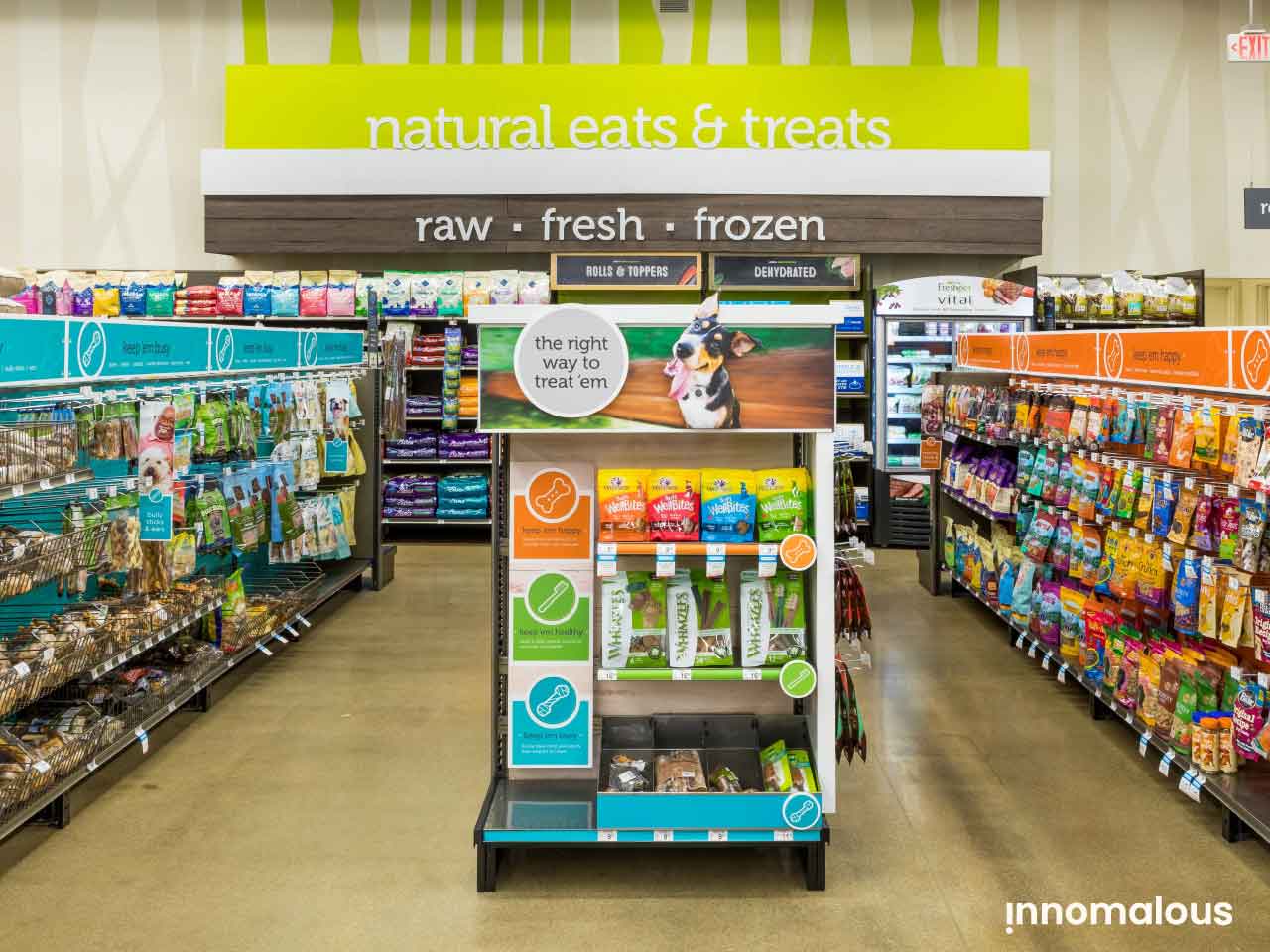
Deciphering Pet Food Labels and Packaging
Pet food packaging and labels are an insightful look into what is inside the packaging. They offer consumers essential information to help them make a purchase decision. This impact of labels leads to many brands providing deliberately vague or misleading information on their packaging.
This section will guide you to launch your pet food range so you can understand existing pet foods and make choices for yours.
From ingredients to nutritional info, let us dive into the essentials, ensuring that every product you create follows regulations and meets the nutritional needs of pets and their owners.
What Is an Ingredient Label and How To Read It
Pet food ingredient labels serve as a nutritional roadmap, detailing the components that make up the product. The order in which ingredients are listed is crucial as it reflects their proportion by weight in the formula.
Ingredients at the beginning of the list have higher quantities, while those near the end contribute less to the overall composition. This hierarchy enables consumers to discern the primary components of pet food.
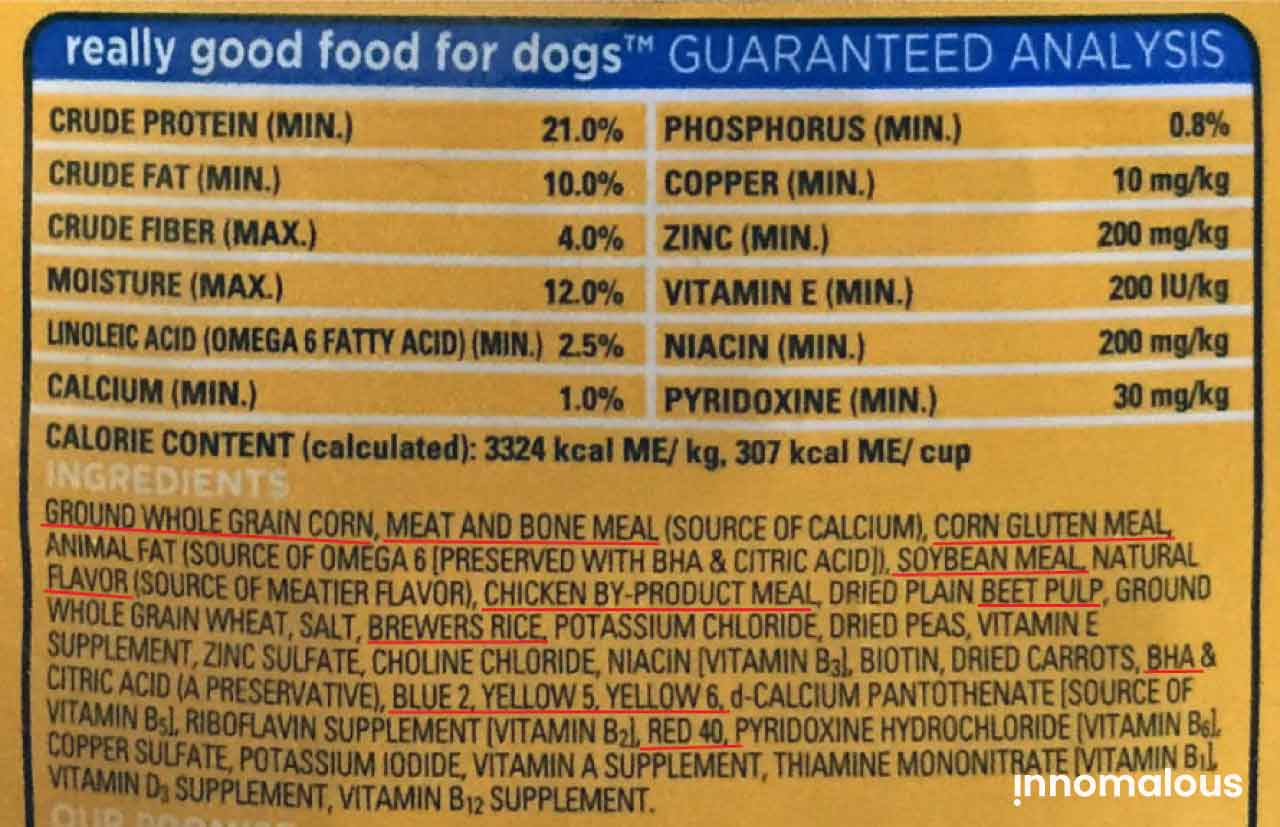
When scrutinizing labels, it is essential to prioritize specific, recognizable protein sources, understand the distinction between real and processed ingredients, and be mindful of vague terms.
Understanding and Assessing Ingredients
Identifying Real Ingredients in Pet Foods
In pet nutrition, real ingredients refer to whole, unprocessed foods like whole meats and vegetables. These maintain more of their natural nutrients.
Conversely, processed ingredients are altered for cost, convenience, or shelf stability. While not always inherently bad, it is essential to note that their nutritional value can differ from their unprocessed counterparts.
Look for whole, recognizable ingredients. Real meats, vegetables, and grains should preceed generic terms or fillers. Be wary of vague terms like "meat by-products" or "animal digest." Opt for specific protein sources, such as "chicken" or "lamb," for transparency.
Including whole grains, such as rice and oats, adds nutritional value to pet food. Contrarily, excess fillers like corn or wheat may signal a lower-quality product with diminished health benefits.
Understanding Pet Food Additives
Colors, flavors, and preservatives are additives that contribute to the pet food’s appearance, taste, and shelf life. Additives can vary in quality and form (artificial, nature-identical, nature-derived, natural) and hence affect pet health at varying degrees of severity.
Premium pet foods derive colors and flavors from natural sources, steering clear of artificial additives. Taste enhancers can be natural, like real chicken, chicken broth, fish, etc. Prioritizing natural options contributes to a healthier choice for pets, lowers allergies, and reduces the chances of consumer complaints.
Quality pet foods also opt for natural preservatives such as tocopherols (vitamin E) and ascorbic acid (vitamin C) or modern food processing technologies like dehydration or retort-packing to improve shelf life. Artificial preservatives like BHA, BHT, and ethoxyquin are generally best avoided due to potential health concerns.
Salt Divider Test in Pet Food
The salt divider test is a valuable tool for both consumers and pet food industry professionals, providing a practical way to gauge the proportions of ingredients in pet foods.
The maximum limit for salt in pet foods is 1%. The ingredients listed after salt likely fall below the 1% threshold. This knowledge helps consumers avoid falling for marketing tactics that may emphasize certain ingredients without them being present in significant quantities.
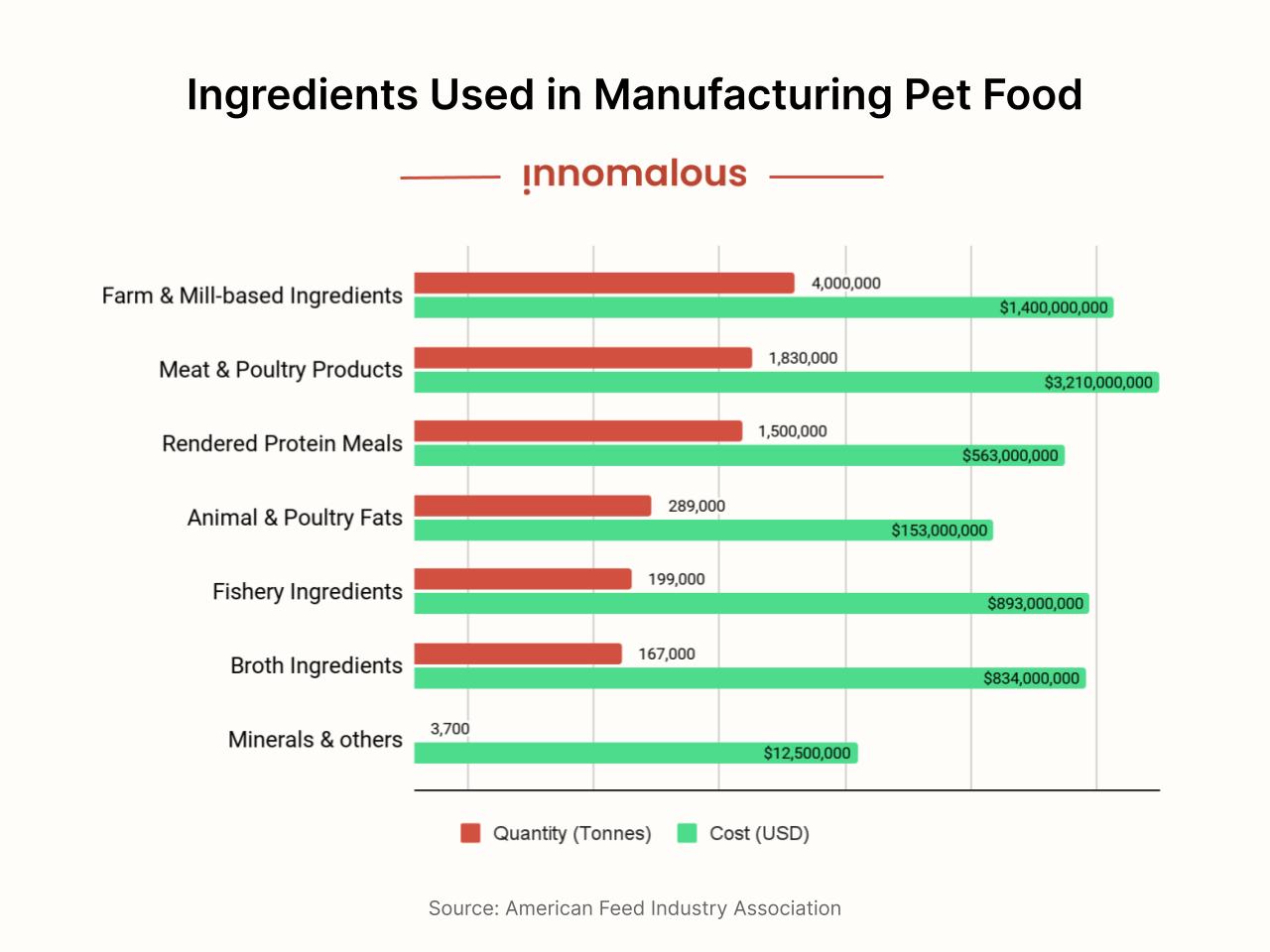
Decoding Pet Food Marketing Terms
Navigating pet food packaging can feel like deciphering a language of its own. Understanding the marketing terms used on labels is crucial for making informed choices. Let us demystify some frequently used terms.
Human-Grade
This term suggests that the ingredients used meet the standards for human consumption. However, it does not necessarily mean the final product is suitable or balanced for humans.
Natural
Ingredients labeled as "natural" should be minimally processed and free from artificial additives. Be cautious, as this term does not guarantee the absence of processing aids or certain naturally derived additives.
Nature-Identical
While it implies a synthetic substance mimics a natural one, it does not necessarily mean the ingredient is derived from natural sources.
With Added XYZ
Indicates the presence of a specific ingredient, but it does not reveal the quantity. Always check the ingredient list for a clearer picture.
No Added Chemicals
All foods, including pet foods, are made up of chemicals. This term often implies a product is free from synthetic additives.
Organic
Pet foods labeled as organic must adhere to specific production standards. Look for certifications like USDA Organic for authenticity.
Grain-Free
This term indicates the absence of traditional grains like wheat or corn. However, it does not guarantee a carb-free product, as alternative carbohydrates may still exist.
Limited Ingredient
Implies a simplified recipe with fewer ingredients. Such food could potentially benefit pets with sensitivities. However, the quality of those ingredients matters.
Holistic
This term suggests a focus on overall well-being. Be cautious, as it lacks a standardized definition in the pet food industry.
Premium
Often used to imply higher quality, but it lacks a standardized definition in the pet food industry.
Complete and Balanced
Indicates that the pet food contains all necessary nutrients for a specific life stage. Ensure it meets BIS or AAFCO standards.
By-products
Refers to secondary products produced during the manufacturing process. While some can be nutritious, some can be low quality and even harmful to pet health.
GMO-Free
Indicates the absence of genetically modified organisms. However, pet foods may not commonly contain GMO ingredients.
Gluten-Free
Implies the absence of gluten, which is essential for pets with gluten allergies. However, it does not necessarily make a product healthier.
Sensitive Stomach Formula
Designed for pets with digestive sensitivities. The effectiveness depends on the specific ingredients used.
Weight Management
Formulated to help pets maintain a healthy weight. Check for specific strategies, such as controlled portions or added fiber.
Probiotics
Beneficial bacteria that can support digestive health. The quantity and strain are essential for effectiveness.
Understanding these terms empowers pet parents and industry professionals to see beyond marketing claims, ensuring that the pet food they choose aligns with their quality and nutritional value expectations. Stay informed, and let transparency guide your decisions in crafting and selecting top-notch pet nutrition.
Understanding Pet Food Processing Technologies
Pet food processing involves various techniques, each impacting the nutritional composition and characteristics of the final product. Let us explore some key processing technologies and their implications.
Extrusion
Extrusion stands as a cornerstone in the pet food manufacturing process. It influences the final product’s texture, palatability, and nutritional content.
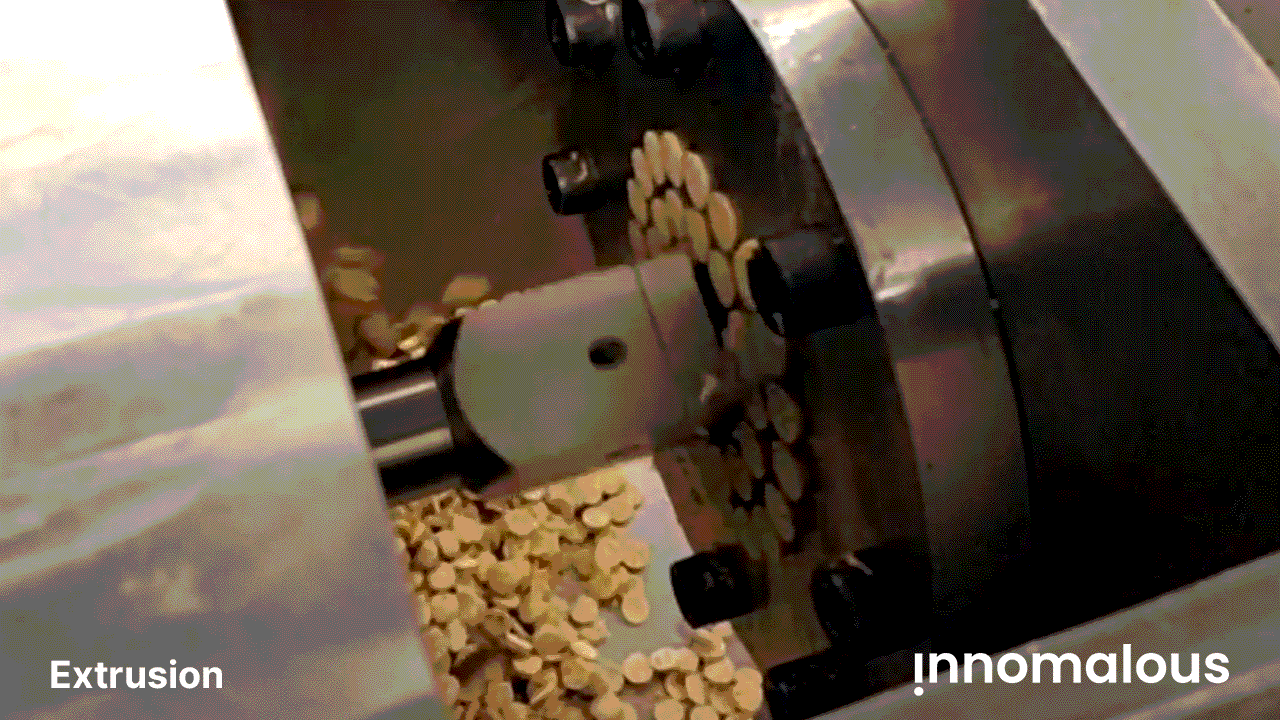
This technique involves subjecting raw ingredients to high pressure and temperature, forming a dough-like consistency, then shaping it into familiar kibble or pellet forms. While widely adopted in the industry for its efficiency, extrusion has its intricacies.
Pros:
Enhanced Digestibility
Extrusion effectively breaks down starches and proteins, rendering them more digestible for pets.
Pathogen Elimination
The high temperatures involved kill harmful bacteria, ensuring a safer end product.
Texture and Shape Control
Extrusion allows for precise control over the texture and shape of the final pet food, contributing to palatability.
Cost-Effective Production
The speed and efficiency of extrusion make it a cost-effective method for large-scale production.
Cons:
Nutrient Loss
Despite its benefits, extrusion can lead to losing heat-sensitive nutrients, such as certain vitamins and amino acids.
Limited Ingredient Variety
Certain ingredients may not withstand the high temperatures and pressure of extrusion, limiting the variety of usable ingredients.
Processing Affects Antioxidants
The process can impact the stability of antioxidants, affecting the product’s longevity.
Products Manufactured Using Extrusion:
Dry Kibble
The most common extrusion application is creating the crunchy and convenient dry kibble that dominates the pet food market.
Baked Treats
Extrusion is also employed to produce a variety of pet treats, offering flavor and texture.
Pellets for Herbivores
Beyond traditional pet foods, extrusion produces pellets for herbivorous pets like rabbits and guinea pigs.
Air-Drying or Dehydration
Air drying is a method that balances efficiency with nutrient preservation, offering a distinctive approach to crafting pet nutrition.
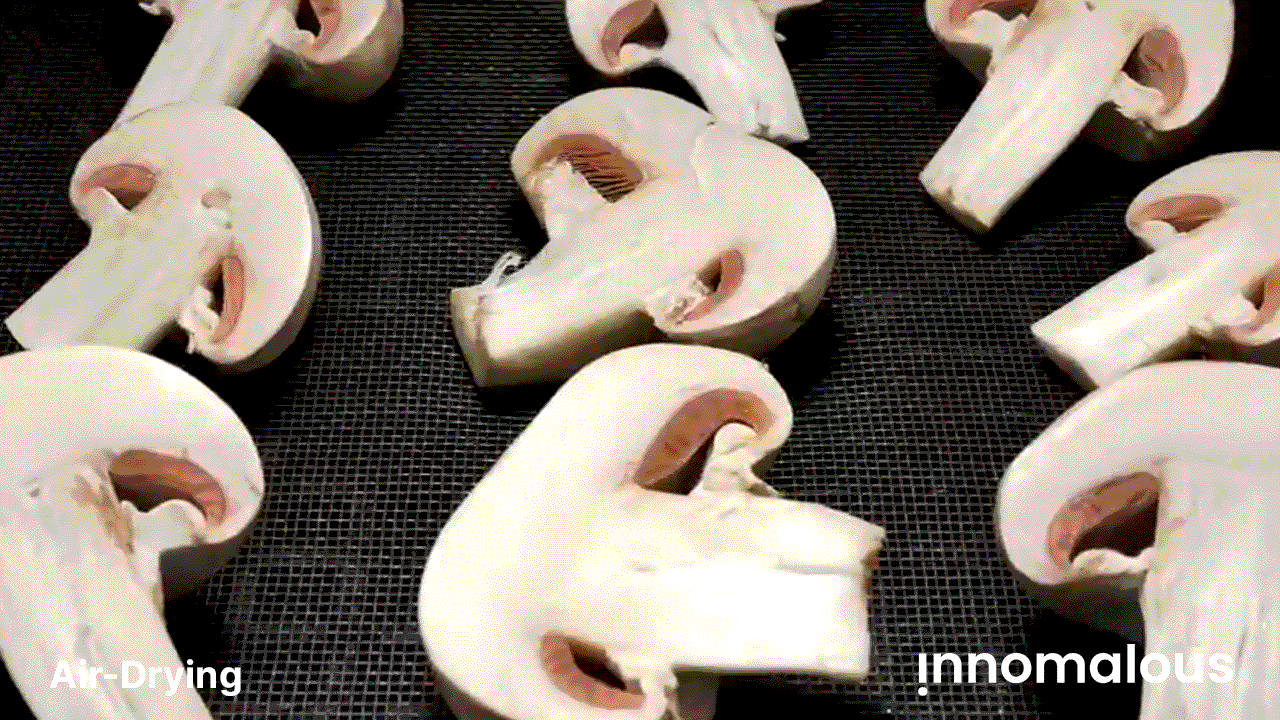
This technique involves slowly dehydrating a raw ingredients mixture using circulating air, yielding pet foods with a unique texture and enhanced nutritional benefits.
Pros:
Gentle Nutrient Preservation
Air-drying maintains the integrity of heat-sensitive nutrients, ensuring that the final product retains more of its original nutritional value.
Texture Retention
Unlike more aggressive methods, air-drying preserves the natural texture of ingredients, contributing to the palatability of the pet food.
Limited Ingredient Exposure to Heat
This method exposes ingredients to lower temperatures for an extended period, reducing the risk of nutrient loss compared to high-temperature processes.
Reduced Pathogen Risk
While not as intense as extrusion, air-drying helps reduce the risk of harmful pathogens, contributing to a safer product.
Cons:
Slower Production
Air-drying is slower than extrusion, making it less suitable for large-scale production.
Cost Considerations
The extended drying time and specialized equipment can make air-drying more expensive.
Storage Sensitivity
Air-dried pet foods may be more susceptible to moisture absorption, impacting their shelf life if not stored properly.
Products Manufactured Using Air-Drying:
Air-Dried Treats
This method is commonly employed to produce palatable and nutrient-rich treats, providing a healthier alternative to traditional treats.
Limited Ingredient Diets
Air-dried formulations often appeal to pets with sensitivities, as they often feature a simplified ingredient list.
Freeze-drying
Freeze-drying is a method that marries the benefits of preservation and nutritional retention.
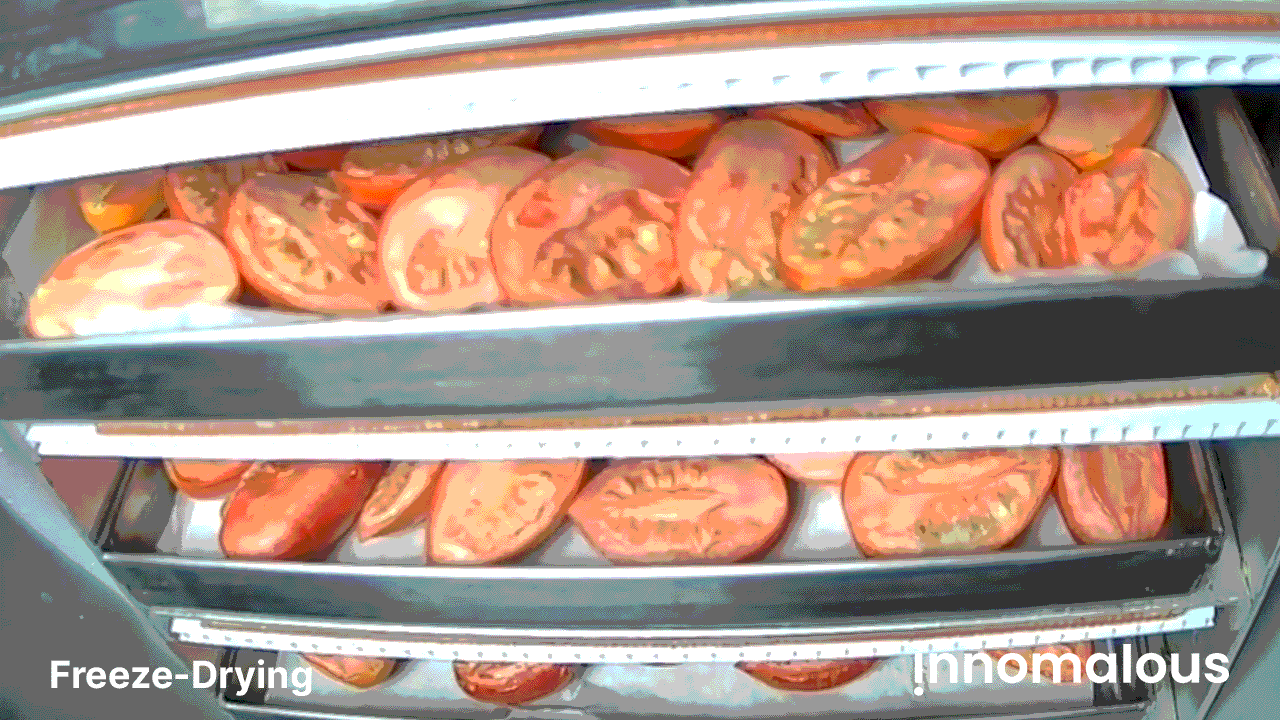
This technique involves freezing raw ingredients and removing the water content under vacuum conditions, creating a lightweight and shelf-stable product.
Freeze-drying is renowned for preserving the natural qualities of ingredients.
Pros:
Optimal Nutrient Retention
Freeze-drying excels in preserving the nutritional integrity of ingredients, maintaining the original freshness and quality.
Lightweight and Convenient
The process removes water content, resulting in a lightweight product that is easy to handle, store, and serve.
Long Shelf Life
The low moisture content achieved through freeze-drying contributes to an extended shelf life, reducing the need for artificial preservatives.
Palatability
The process often enhances the flavor of ingredients, contributing to the palatability of the final product.
Cons:
Cost Intensive
Freeze-drying is energy-intensive, making it more expensive than other drying methods.
Equipment Complexity
The specialized equipment required for freeze-drying adds to the complexity and cost of the production process.
Limited Production Scale
Like air-drying, freeze-drying might not be as scalable for large production volumes.
Products Manufactured Using Freeze-drying:
Freeze-Dried Treats
This method is commonly used to create treats with intense flavors and minimal nutrient loss.
Raw Food Diets
Freeze-drying is employed in some raw pet food formulations, providing a convenient and shelf-stable alternative to frozen raw diets.
Baking
Baking is a time-honored method that infuses products with a comforting warmth and distinct flavor profile.

This traditional technique involves cooking pet food in an oven, and while it may lack the speed of extrusion, it brings its advantages.
Pros:
Gentle Nutrient Preservation
Baking is generally gentler compared to high-temperature processes, preserving the natural goodness of ingredients.
Texture and Aroma Enhancement
The slow cooking process enhances the final product texture, contributing to palatability. The aroma of baked foods can also be enticing for pets.
Limited Ingredient Exposure to Heat
While subjected to heat, the exposure is generally less intense than in extrusion, minimizing nutrient loss.
Natural Flavor Enhancement
Baking can intensify the natural flavors of ingredients, creating a savory and appealing taste.
Cons:
Longer Production Time
Baking is a slower process compared to extrusion, impacting production efficiency.
Potential for Uneven Cooking
Achieving uniform consistency can be challenging, leading to variations in texture, nutrient distribution, and compromised shelf-life.
Limited Shape Control
Unlike extrusion, which offers precise shape control, baking may result in less uniform shapes.
Products Manufactured Using Baking:
Baked Treats
Baking is a common method for creating a variety of pet treats, from biscuits to cookies, offering a delightful and crunchy texture.
Soft-Baked Treats
Baked soft treats provide a chewy and palatable option for pets even though they may have a shorter shelf-life without added preservatives.
Retort-Packing
Retort-packing is a method that balances safety with shelf stability, particularly in wet pet foods.
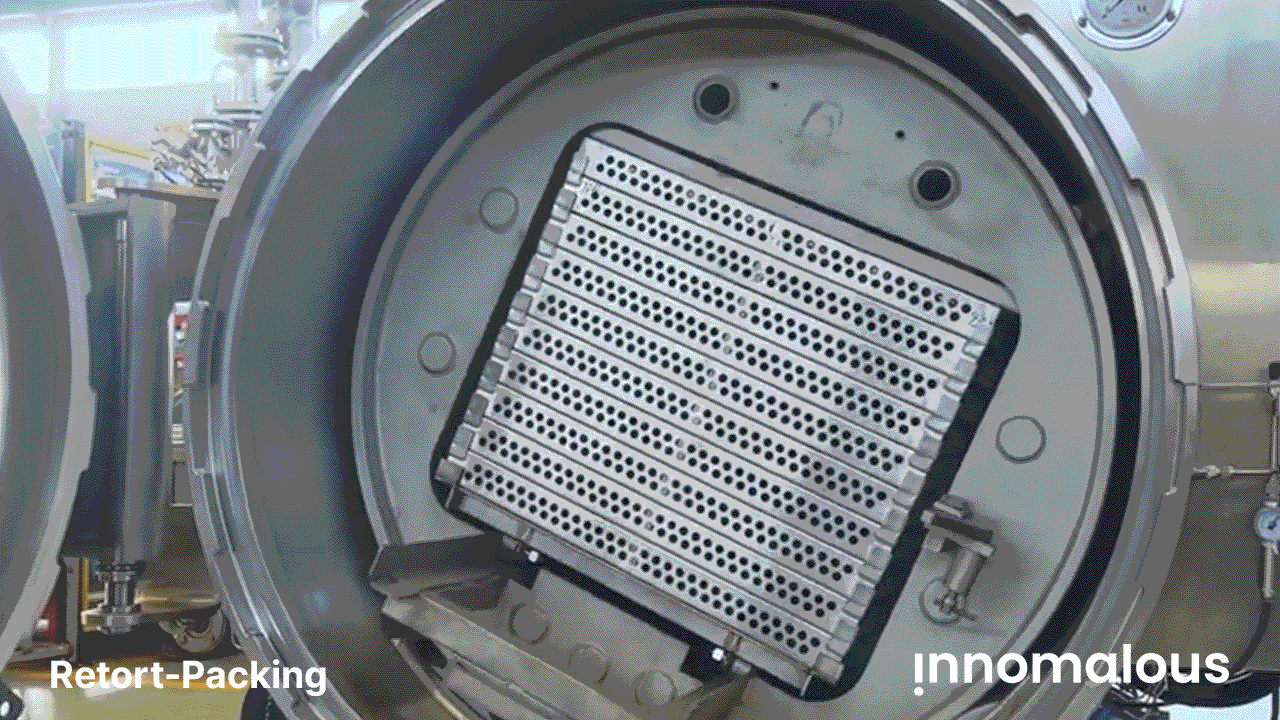
This technique involves hermetically-sealing pet food in specialized pouches and heat-sterilizing them, effectively eliminating harmful bacteria and ensuring a longer shelf life.
Pros:
Pathogen Elimination
Retort-packing involves heat treatment that eradicates harmful bacteria, guaranteeing the safety of the final product.
Extended Shelf Life
Sealing pet food in pouches under high temperatures contributes to an extended shelf life, reducing the need for artificial preservatives.
Convenient Packaging
Retort pouches are lightweight, easy to store, and convenient for pet parents to travel with and handle.
Versatility
This method is versatile and applicable to a wide range of wet pet food formulations.
Cons:
Texture Impact
While effective in ensuring safety and longevity, the heat processing in retort-packing can affect product texture.
Nutrient Loss
The high temperatures involved may lead to some nutrient loss, especially in heat-sensitive vitamins and antioxidants.
Products Manufactured Using Retort-Packing:
Wet Pet Foods
Retort-packing is a production method for wet pet foods. These foods include stews, gravies, chunky meat formulations, and nutrient-rich bone broths.
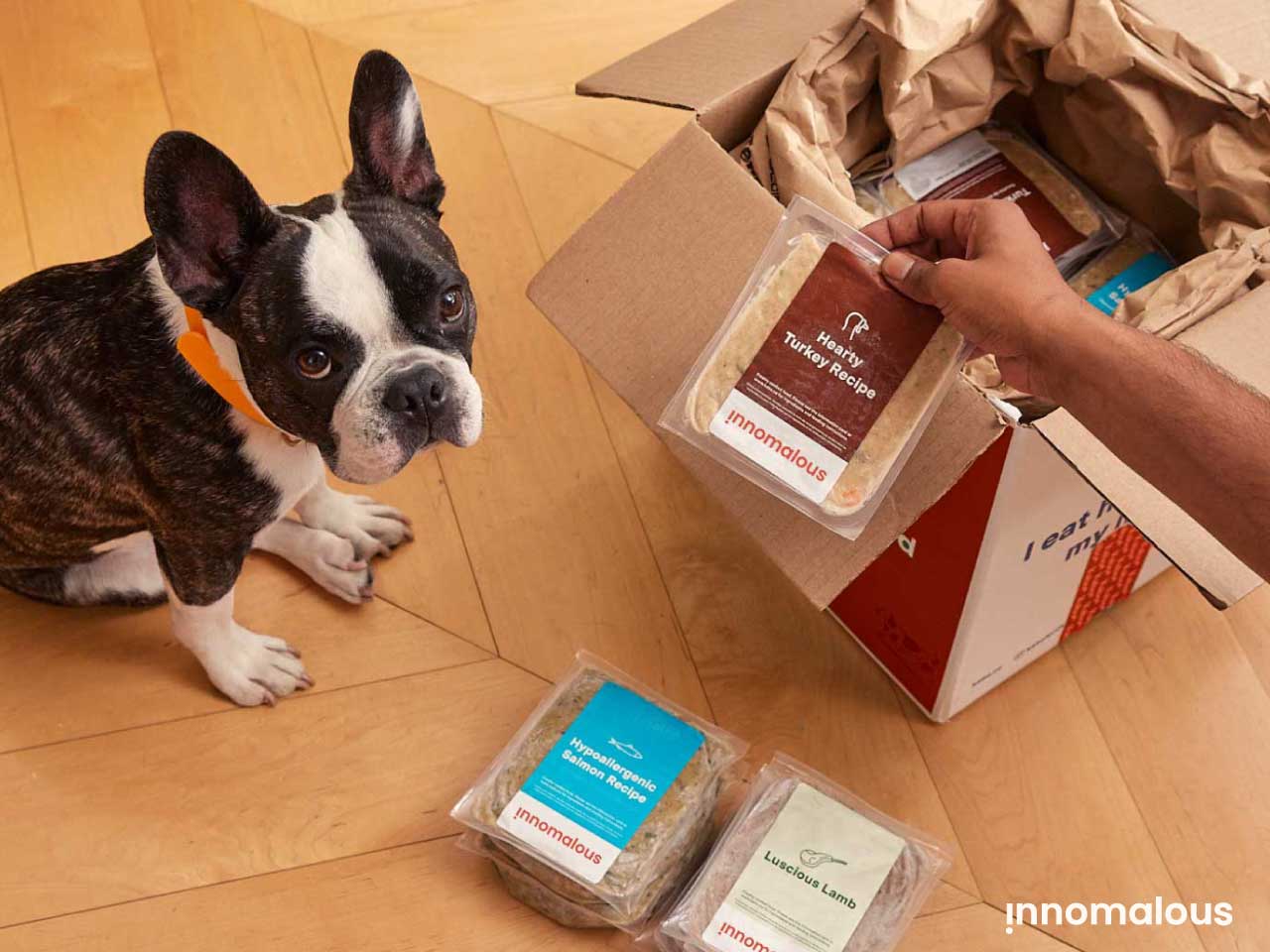
These techniques can be used individually or in combination. Other preliminary raw material processing methods can also take place before these steps. These methods can include,
Bleaching
Used to lighten the color of ingredients. It can affect nutrient content and is generally avoided in high-quality pet foods.
Rendering
Converts meat and fat into stable, usable materials. While it can eliminate harmful bacteria, the high temperatures may negatively affect the nutritional profile.
Homogenization
Creates a uniform texture by breaking down and distributing fat particles. It’s beneficial for texture but may impact the overall nutrient stability.
As a business selecting pet foods to launch under your brand name, you must demand transparency from your pet food manufacturer about the techniques used in the manufacturing process.
Choose techniques that achieve balance and do not compromise pet health.
8 Steps to Strategically Evaluate Quality in the Pet Food Market
Launching a pet food brand demands a keen understanding of the market landscape and a strategic approach to stand out amidst the competition. Here is a targeted process for pet food entrepreneurs to assess and compare product quality, aiding in the decision-making process for market positioning.
Step 1: Ingredient Scrutiny
Conduct a meticulous review of ingredient lists in competitor products. High-quality options emphasize real, recognizable ingredients, steering clear of vague fillers and byproducts.
Step 2: Ingredient Transparency
Unravel the transparency in ingredient lists. High-quality brands are forthright about the origin and nature of their ingredients. Beware of products with vague terminology or undisclosed sourcing.
Step 3: Nutritional Analysis
Scrutinize the guaranteed analysis on competitor labels. High-quality products often boast well-balanced nutritional profiles, meeting the specific needs of pets.
Step 4: Manufacturing Techniques
Differentiate between manufacturing techniques employed by competitors. Extrusion, air-drying, freeze-drying, or retort-packing each carries its implications for product quality. Understand the impact on nutritional content and overall appeal.
Step 5: Brand Reputation
Investigate the reputation of competing brands. Established and reputable brands often adhere to stringent quality standards. Recognize the strengths and weaknesses of competitors to inform your brand strategy.
Step 6: Certifications and Standards
Look for certifications on competitor products. Recognized certifications, such as those from ISO, HACCP, and GMP, signify adherence to industry standards. Evaluate the impact of these certifications on consumer perception.
Step 7: Pricing Strategy
Analyze the pricing strategy of competitor products. While not the sole indicator, significant price variations may signal differences in ingredient quality, production methods, or brand positioning.
Step 8: Expert Consultation
Consult with veterinarians, pet nutritionists, or pet food formulators. Gather insights into how competitor products align with professional standards. Understand the nuances that could impact consumer trust.
By systematically evaluating existing market offerings, you can decipher the landscape and identify opportunities to position your brand strategically. This in-depth understanding empowers you to make informed decisions about where your brand fits in the spectrum of pet food quality, enabling you to carve a distinctive niche in the competitive market.
Navigating The Six Pricing Segments in the Pet Food Market
Understanding the diverse pricing segments within the pet food market is essential for entrepreneurs aiming to position their brands effectively. Below is a nuanced exploration of pricing categories, allowing you to make informed decisions aligned with your brand strategy.
Economy or Budget Segment
Characteristics: Positioned as affordable options catering to price-conscious consumers.
Ingredients: Often includes more economical ingredients and fillers, and may have lower meat content.
Target Audience: Budget-conscious pet owners seeking cost-effective solutions.
Considerations: Emphasizes price competitiveness over premium ingredients or nutritional quality.
Future Outlook: Faces challenges due to increasing consumer awareness about the importance of quality nutrition. May experience more intense competition as new brands enter the market.
Mid-range or Mainstream Segment
Characteristics: Strikes a balance between affordability and perceived quality.
Ingredients: Typically includes a mix of standard and higher-quality ingredients.
Target Audience: Pet owners willing to invest in better quality without premium pricing.
Considerations: Aims to capture a broader consumer base by offering reasonable quality at a moderate price point.
Future Outlook: Expected to remain a stable segment, with steady growth as consumers prioritize quality within budget constraints.
Premium Segment
Characteristics: Positioned as higher quality with enhanced nutritional offerings.
Ingredients: Focuses on premium and natural ingredients, often with specific health benefits.
Target Audience: Pet parents willing to invest more for superior quality and nutritional value.
Considerations: Appeals to consumers who prioritize their pet’s health and are willing to pay a premium for top-tier ingredients.
Future Outlook: Rapid growth anticipated as the humanization of pets drives demand for premium, health-focused products. Potential for innovations in unique ingredients.
Specialty or Niche Segment
Characteristics: Targets specific dietary needs, lifestyles, or unique ingredient preferences.
Ingredients: Tailored to address specific health concerns or dietary restrictions.
Target Audience: Pet parents seeking specialized solutions for their pet’s unique requirements.
Considerations: Explores niche markets, offering specialized formulations that may command higher prices.
Future Outlook: Promising growth as consumers become more conscious of specific pet dietary requirements. Opportunities for expansion in niche markets.
Veterinary or Prescription Segment
Characteristics: Formulated to address specific health conditions, often recommended by veterinarians.
Ingredients: Focuses on therapeutic ingredients tailored to manage specific ailments.
Target Audience: Pet owners with pets requiring prescription diets for medical reasons.
Considerations: Requires veterinary endorsement, usually sold through veterinary channels. May command higher prices for specialized formulations.
Future Outlook: Steady growth is anticipated due to the rising awareness of pet health issues. Increasing collaboration between pet food manufacturers and veterinarians.
Super Premium or Luxury Segment
Characteristics: Positioned as the epitome of pet culinary experiences, offering the finest ingredients.
Ingredients: Features exotic or gourmet ingredients, emphasizing exclusivity and indulgence.
Target Audience: High-income pet parents seeking luxury experiences for their pets.
Considerations: Commands premium prices and emphasizes the exclusivity and uniqueness of the ingredients.
Future Outlook: Expected growth is driven by the premiumization trend and the desire for luxury pet experiences.
Understanding these pricing segments allows you to strategically position your brand, catering to your target audience’s needs and preferences. By aligning pricing with the perceived value and quality of the product, you can navigate the competitive pet food market with precision.
The Types of Pet Food Products
Diving into pet food entrepreneurship requires understanding the diverse pet food products available. This comprehensive guide aims to equip entrepreneurs with insights into the various types of pet food products, empowering them to make informed decisions aligned with their brand vision.
From traditional kibble to gourmet treats, the pet food landscape offers many options, each catering to specific consumer preferences and pet needs. Let us explore the options so you can select offerings that align with their brand identity and target audience.
Pet Food (Primary Diet)
The primary diet is the cornerstone of a pet’s well-being, reflecting pet parents’ preferences and nutritional philosophies. From the familiar crunch of traditional kibble to the freshness of frozen meals, each option in the primary diet spectrum caters to specific dietary needs and consumer expectations.
Traditional Kibble

Traditional kibble is dry, hassle-free, small pellets made through extrusion. They have a long shelf life, convenient storage, and are cost-effective.
Considerations: Traditional kibble may contain more fillers, vague ingredients, and added harmful chemicals. The inferior quality raw material used in manufacturing such food may attract pests. Prolonged consumption of low-quality kibble may lead to renal issues, weight gain, periodontal issues, etc. in pets.
Market Segment: Economy to Mid-range, Veterinary
Natural Kibble

Natural kibble is similar to traditional kibble but emphasizes natural and wholesome ingredients without artificial additives. It appeals to pet parents seeking a balance between convenience and natural nutrition.
Considerations: The higher quality ingredients used in natural kibble can make the product pricey. The USP of such a product is not necessarily its price, but its quality. Entrepreneurs should focus on curating marketing that emphasizes these aspects to justify the higher price.
Market Segment: Mid-range to Super Premium, Veterinary
Dehydrated/Air-Dried/Oven-Baked Pet Food

Dehydrated air-dried or oven-baked pet food is a higher quality option prepared by removing moisture from ingredients under moderate heat and over long durations. Such foods retain nutritional value, are often free from preservatives, and offer a distinct texture.
Considerations: Like natural kibble, dehydrated pet foods will retail at a higher cost. Brands can emphasize the nutritional benefits, high quality, and unique processing to market to their customers.
Market Segment: Premium to Super Premium
Rehydratable Pet Food

Rehydratable pet food is dehydrated pet food that requires adding water before serving. It offers pets a fresh meal without the effort of daily preparation, freezing, and such. Rehydratable food is gently processed. This means it retains the nutritional value of the food and offers all the benefits of a fresh diet with the convenience of dry food.
Considerations: Some consumers may be unfamiliar with the rehydration process. Entrepreneurs should offer clear instructions on preparing the food and highlight its convenience and health benefits.
Market Segment: Mid-range to Super Premium
Wet Gravy Food

Wet food with a gravy-like consistency contains high preservatives and low-quality ingredients. It is a budget-friendly option and may improve the palatability of traditional kibble due to its added synthetic flavors and taste enhancers.
Considerations: Low-quality ingredients like starches and MDM may lead to potential pet health issues.
Market Segment: Economy
Retort-Packed Natural Wet Food

Better quality ingredients than traditional gravy pet food are used in making retort-packed wet food. It is heat-treated to offer a long shelf life without added preservatives. Retort-packed food is convenient to store as it does not require refrigeration. It is also easy to serve and travel with.
Considerations: Natural wet food may be pricier than traditional gravy. Brands should create awareness about the quality of ingredients and state-of-the-art technology used to manufacture these products.
Market Segment: Mid-range to Premium
Frozen Fresh Food

As the name suggests, frozen fresh food is prepared with fresh natural ingredients, raw or cooked, and is frozen to preserve nutrients. It is minimally processed and hence retains nutrients and flavors well.
Considerations: The frozen nature of such foods can cause logistics complications and limit the distances brands can service. The product has a low shelf-life once thawed. It can also be inconvenient for pet parents who are uncomfortable storing non-vegetarian foods in their freezer.
Market Segment: Mid-range to Super Premium, Specialty
Pet Treats
Treats are delightful supplementary pet foods that facilitate moments of joy, training, and bonding between pets and their parents. This section illuminates the diverse realm of pet treats so you can create offerings that captivate canine palates and align with your brand’s identity in this flourishing market.
Chews

Chews are long-lasting pet treats designed for extended chewing. They support dental health and entertain.
Considerations: Chews can be made with a wide range of ingredients. They can be ultra-processed or natural. Some chews can splinter and pose a hazard for choking or internal injuries.
Market Segment: Economy to Premium
Rawhide

Rawhide are chewable treats made from animal hide. They keep pets occupied and may improve dental health.
Considerations: Animal hide is processed and bleached at multiple levels to make rawhide. This low-quality nature of rawhide can lead to health issues in pets on continuous use. In the short term, rawhide can cause digestive issues in some pets.
Market Segment: Economy
Milk Bones

Milk bones are crunchy pet treats that are affordable and convenient.
Considerations: Milk bones are usually made with inferior-quality ingredients and can contain harmful additives. This quality is also a reason for their surprisingly low cost.
Market Segment: Economy
Dog Biscuits

Dog biscuits are baked, crunchy, bite-sized treats. They are available in various shapes, flavors, and price points, making them a versatile treating option.
Considerations: Like chews, dog biscuits can be made with various raw materials and are usually high on fillers. They can range from downright harmful to organic and exotic. It is important to consider the makeup of the dog biscuits and market them to the right audience appropriately.
Market Segment: Economy to Premium
Soft Chewy Treats

Soft chewy treats are gummy pet treats that may also have a moist center. They are highly palatable owing to artificial flavors and taste enhancers. Soft treats are suitable for pets with dental issues.
Considerations: Soft treats, due to their form factor, are mostly synthetic and contain additives, preservatives, and taste enhancers. Such artificial ingredients can affect pet health adversely in the long term.
Market Segment: Economy to Mid-range
Natural Bite-sized Treats

Natural bite-sized treats are made with real ingredients. They have a natural appeal and are highly palatable and effective as high-value training treats.
Considerations: Natural treats may retail at a higher price point than their traditional counterparts. However, they do offer significantly higher value and performance.
Market Segment: Mid-range to Premium
Jerky Treats

Jerkies are natural, dried real meat treats. They are extremely high quality and have great natural palatability. Jerkies can be made with many different types of meats and offer high protein content to pets.
Considerations: Some soft chewy treats may also refer to themselves as jerky treats, but these are highly processed synthetic treats, not to be confused with natural air-dried meat jerky treats.
Market Segment: Premium to Super Premium
Air-Dried Vegetarian Treats

Single or limited-ingredient vegetarian treats are suitable for pets with dietary restrictions. Vegan or vegetarian pet parents may opt for vegetarian treats for their pets as well.
Considerations: Vegetarian treats have notably lower palatability vs. their meat-based counterparts. They also have limited options due to higher moisture content and price restrictions and may be nutritionally lacking.
Market Segment: Mid-range to Premium
Dehydrated Animal Parts (Feet, Liver, Gizzards, Hoofs, Ears, Necks, Trachea, etc.)

Dehydrated animal parts offer a variety of different textures and flavors for pets. These treats offer an opportunity for the closest replication of the natural chewing behavior in pets. Dehydrated animal parts can enrich raw food meals and improve dental health.
Considerations: The natural appearance of dehydrated animal parts can be off-putting for many pet parents and may discourage them from purchasing.
Market Segment: Mid-range to Premium, Specialty
Creamy Cat Treats

Creamy cat treats are luscious, palatable treats designed for pleasing feline tastebuds. They are easy to serve and versatile.
Considerations: Creamy cat treats, while pricey, may still contain a host of artificial ingredients and additives.
Market Segment: Mid-range to Premium
Pet Supplements
Supplements are a beacon of support, addressing specific health needs and elevating the overall vitality of our cherished companions. This section delves into the diverse landscape of pet supplements, offering entrepreneurial insights to craft enriching solutions that resonate with the evolving needs of pet owners.
Veterinary-Grade Supplements

Veterinary-grade supplements are available in many forms like capsules, tablets, soft chews, and syrups. They are crafted to offer precise health solutions and retail through veterinary endorsements.
Considerations: Since the supplement’s primary objective is to alleviate symptoms and health issues in pets, they are formulated with nutraceuticals and fillers. The palatability often takes a backseat in these products. This leads to difficulty for pet parents feeding their pets veterinary-grade supplements.
Market Segment: Economy to Premium, Veterinary
Natural Pet Supplements

Often presented as meal toppers, natural pet supplements are made with all-natural ingredients including foods that are effective in aiding recovery and preventing severe pet health issues. These ingredients could include ayurvedic herbs, greens, and other potent superfoods. Their natural nature garners a broad appeal from pet parents.
Considerations: Many natural ingredients may not have sufficient scientific evidence or research to back their benefits, while they may have lore or anecdotal evidence of efficacy in humans.
Market Segment: Mid-Range to Super Premium, Specialty
Holistic Health Supplements

Retailed as meal toppers or soft chews, holistic health supplements blend the benefits of nutraceuticals and naturals to offer peak performance and high palatability. They are formulated through a comprehensive wellness approach for safety, convenience, and efficacy.
Considerations: Formulating holistic supplements could be complex and incur high costs. Opt for pet supplement manufacturers like Innomalous that offer pre-formulated recipes so you can save on upfront formulation costs.
Market Segment: Mid-range to Super Premium, Specialty
Novel Pet Edibles
Novel pet edibles are new and innovative products that leverage the green fields in the pet food industry and fill product gaps. These unique items can focus on health and convenience but may also emphasize improving the quality of the human-pet relationship through bonding experiences and creating moments. Let us look at some novel pet edibles taking off in the pet space.
Meal Toppers

Meal toppers enhance the palatability and nutrition of regular food. They are available as dry powders to sprinkle on meals or as gravies to pour.
Considerations: While natural meal toppers bring these benefits through natural ingredients, synthetic variants containing artificial flavors or taste enhancers are available too.
Market Segment: Mid-range to Super Premium, Specialty
Bone Broths

Retort-packed, flavor-dense, and nutrient-rich broths are a versatile product. Parents can use them as a standalone treat or to enhance regular pet meals. They infuse flavor and nutrition into the meal and have a natural appeal.
Considerations: Retort-packed bone broths have high moisture content which can increase logistics costs. Customers may have concerns about storing and using the product too.
Market Segment: Mid-range to Premium
DIY Cake Kits

DIY cake kits are an experiential product that lets pet parents bake a cake for their pets. It is an innovative product that aims at enhancing the connection between the human and their pet by creating moments for bonding.
Considerations: Like all innovative products, DIY Cake Kits call for educating parents on the preparation and serving process. Brands should provide clear instructions to make it simpler for pet parents.
Market Segment: Premium
Breakfast Cereal for Pets

Leveraging the humanization of pets, breakfast cereals for pets are a creative and novel product that helps pets start their day right. Breakfast cereals are made with natural ingredients that are safe for pets similar to human granola, muesli, or other breakfast items.
Considerations: Breakfast cereals are a supplementary food item and should not be mistaken for a pet’s primary diet. They may be nutritionally insufficient as pet food.
Market Segment: Mid-Range to Premium
Navigating Pet Food Trends for Savvy Entrepreneurs
The pet food industry is a dynamic landscape that demands consistent evolution. Trends serve as a guiding light to illuminate the path forward for entrepreneurs. In the pet food context, a trend encapsulates pet owners’ evolving preferences, behaviors, and expectations, reflecting the broader societal shifts in how we perceive and care for our four-legged companions.
5 Reasons Why Brands Should Pay Attention to Pet Food Trends
Consumer Alignment
Staying attuned to trends ensures that brands align with the evolving needs and preferences of pet owners, fostering a deeper connection with the target audience.
Innovation Opportunities
Trends often uncover uncharted territories for innovation, allowing brands to create novel products that resonate with the current zeitgeist.
Competitive Edge
Brands that proactively embrace trends position themselves as industry leaders, gaining a competitive edge in a market driven by ever-changing consumer expectations.
Health and Well-being Focus
Many trends in pet foods revolve around enhancing the health and well-being of pets. Brands focusing on these trends contribute to pet health and appeal to the growing segment of health-conscious pet owners.
Adaptation to Market Shifts
As societal norms and values evolve, pet food trends act as early indicators of these shifts, enabling brands to adapt their offerings in sync with the changing market landscape.
Paying attention to pet food trends is not just a strategic move but a proactive commitment to understanding and serving the needs of modern pet owners. It’s a journey into the hearts and homes of pet enthusiasts, to understand the preferences that shape the present and future of the pet food industry.
So, let us delve into the exciting trends currently shaping the canine culinary landscape.
Pet Food Industry Trends to Watch Out For In 2024
These are some of the prevailing trends shaping the current landscape of the natural pet food industry, providing insightful perspectives for entrepreneurs looking to navigate the wave of evolving preferences in the pet food industry.
Grain-Free Pet Foods
Rising demand for grain-free options aligns with the humanization of pet diets, emphasizing ingredients like meat, vegetables, and legumes while excluding traditional grains.
Brand Opportunity: This trend allows brands to tap into the health-conscious pet owner segment by offering grain-free options. Such formulations often focus on high-quality ingredients providing a nutrient-dense alternative to traditional kibble.
Grain-free options can be suitable for pets with grain sensitivities or allergies, offering an alternative for owners seeking specific dietary solutions.
Functional Foods
Integrating functional ingredients, such as antioxidants, probiotics, and superfoods, into pet foods addresses specific health needs and promotes overall well-being.
Brand Opportunity: Brands can differentiate themselves by focusing on formulations that provide functional benefits, appealing to pet owners seeking proactive health solutions for their furry companions.
Hypoallergenic Foods
Increased awareness of pet allergies has led to a surge in hypoallergenic pet food options, formulated to minimize potential allergens. Hypoallergenic formulations often use a limited number of carefully selected ingredients to minimize potential allergens.
Brand Opportunity: Brands can cater to pets with dietary sensitivities by offering hypoallergenic formulations, providing a tailored solution for pets with specific health considerations.
Vegetarian Pet Foods
A growing interest in vegetarian and plant-based pet diets reflects the broader shift toward sustainable and ethical consumption. Formulations may include sources like lentils, chickpeas, or soy as primary protein sources.
Brand Opportunity: Brands can explore plant-based formulations to appeal to environmentally conscious pet owners, offering a viable alternative without compromising nutritional value.
Alternate Proteins
Beyond traditional meat sources, there’s a rising interest in alternative proteins like insect-based or plant-based proteins like peas, lentils, and quinoa for pet foods.
Brand Opportunity: Brands can embrace sustainability by incorporating alternative protein sources, addressing both the nutritional needs of pets and the environmental concerns of pet owners.
Training Treats
Training treats are small treats with intense flavors to capture a pet’s attention during training sessions. The emphasis on positive reinforcement in pet training has led to a surge in demand for these small, tasty training treats with high palatability.
Brand Opportunity: Brands can create specialized training treat lines with bite-sized, flavorful options that facilitate training sessions. Focus on flavorful formulations without contributing excessive calories, considering the frequency of treat use in training.
Rehydratable Food
Dehydrated pet food that can be rehydrated with water before serving offers a convenient solution for pet owners. Rehydration can enhance the aroma and taste of the food, making it more appealing to pets.
Brand Opportunity: Brands can innovate in the convenience space by introducing rehydratable options, catering to pet owners seeking hassle-free meal solutions.
Air-Dried Pet Food, Dehydrated Pet Food or Oven-Baked Pet Food
Air-drying, oven baking, or dehydration involve minimal heat as compared to extrusion. They thus preserve nutrients while eliminating moisture leading to a nutrition and flavor-dense pet food product.
Brand Opportunity: Brands can explore air-dried formulations to offer a nutrient-dense alternative, appealing to pet owners seeking minimally processed options.
Lickable Strip Supplements
The emergence of lickable strip supplements provides a novel way to administer nutritional supplements to pets. Strips offer an alternative to traditional supplement formats, allowing pets to lick or consume the supplement effortlessly.
Brand Opportunity: Brands can explore innovative supplement delivery methods, addressing the preferences of pet owners looking for easy and enjoyable ways to support their pet’s health. Pay emphasis on creating flavors that appeal to pets, making supplement administration more enjoyable.
In Closing
The pet nutrition landscape is evolving, mirroring the shifting preferences and expectations of pet owners. From the historical roots of the industry to the cutting-edge trends shaping the present, our exploration has unveiled the innovation, challenges, and opportunities in the pet food industry.
For aspiring entrepreneurs in the pet food realm, the key lies not only in understanding the current trends but also in deciphering the nuanced needs of pet owners. It’s about crafting products that resonate with the health-conscious, environmentally aware, and discerning consumers who view their pets as cherished family members.
Remember, the pet food industry is not just about feeding animals; it’s about nourishing relationships, fostering well-being, and contributing to a healthier, happier world for pets and their devoted parents.
Your journey is as significant as the destination. Partnering with a white-label natural pet food manufacturer like Innomalous that believes in innovation, transparency, and keeping pets first makes your business journey more fulfilling. Contact us today to start curating your pet food products.
Frequently Asked Questions (FAQs)
Why are grain-free pet foods gaining popularity?
Grain-free options appeal to pet owners seeking pet foods that mimic the ancestral, protein-rich pet diets. These formulations prioritize high-quality proteins, vegetables, and legumes while excluding traditional grains.
What’s the significance of alternate proteins in pet foods?
Beyond traditional meat sources, alternate proteins (insects, plant-based) cater to sustainability concerns in pet foods. They offer protein-rich alternatives while addressing environmental considerations.
How can I assess the quality of pet food products?
Assessing quality of pet foods involves scrutinizing ingredients, processing techniques, and packaging. Look for high-quality, natural ingredients, and transparent labeling, and consider factors like extrusion, air-drying, or freeze-drying in processing.
What pricing segment should I target for my pet food brand?
The pricing segment depends on your brand positioning. Premium segment pet foods offer high-quality ingredients, mid-range balances affordability with quality, and economy focuses on cost-effective options.
Why does the ingredient list on a pet food product not align with the marketing terminology on the front of the pack?
The front-of-pack marketing often emphasizes selling points to attract consumers. However, the detailed ingredient list provides a more accurate breakdown, revealing the actual composition of the pet food product. It’s crucial to scrutinize the entire package for a comprehensive understanding.
Do pet food brands need FSSAI?
No, until this article was written, FSSAI (Food Safety and Standards Authority of India) regulations do not apply to pet foods. These regulations are designed for human food products. However, adherence to BIS quality standards and transparency is encouraged for the pet food industry.
How can start-ups decide which pet foods to launch?
Starting a pet food brand involves understanding your target audience, conducting market research, and aligning with industry trends. Consider factors such as ingredient quality, processing techniques, and pricing segments. Tailor your product range based on the needs and preferences of pet owners in your target segment.
Are natural and organic pet foods the same thing?
While both terms suggest a focus on high-quality ingredients, “natural” implies minimal processing and additives, while “organic” indicates adherence to specific agricultural standards. Not all natural foods are organic, and vice versa.
Is there a significant difference between traditional kibble and natural kibble?
Natural kibble emphasizes high-quality, minimally processed ingredients, often excluding artificial additives. Traditional kibble may include more conventional ingredients and processing methods. The distinction lies in the emphasis on natural, wholesome components.
How do I choose between various pet treat options for my business?
Selecting pet treats involves understanding the preferences of your target audience. Consider factors like treat size, ingredients, and health benefits. Offering a variety, including training treats and natural bite-sized options, caters to diverse consumer needs. You can also schedule a call with an Innomalous representative for product selection assistance.
Are there specific trends that impact the pricing segments of the pet food market?
Yes, trends like premiumization and the demand for functional foods can influence pricing segments. Entrepreneurs should align their pricing strategy with consumer expectations and the perceived value of their products.

